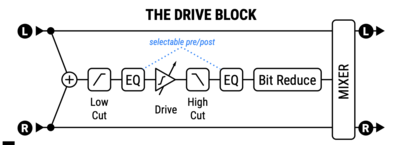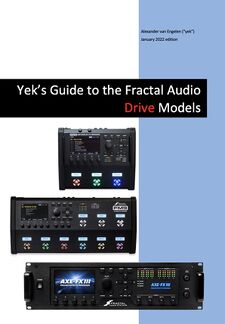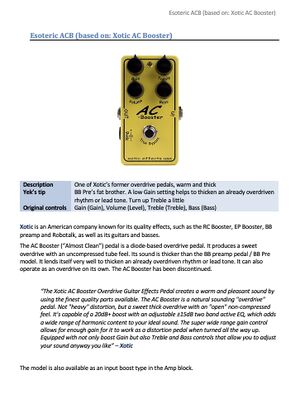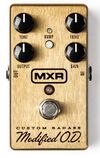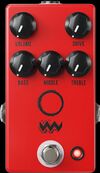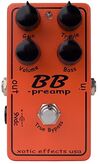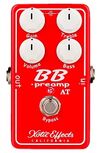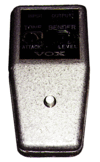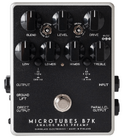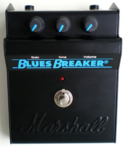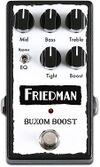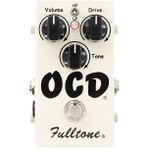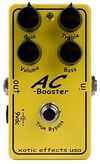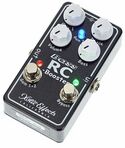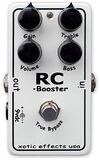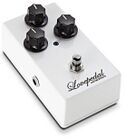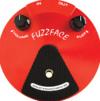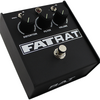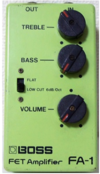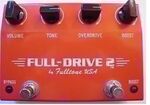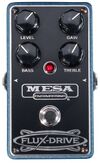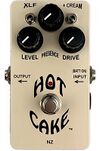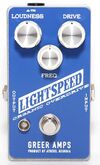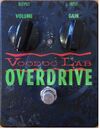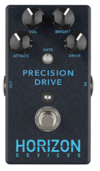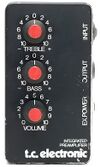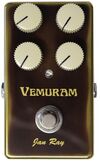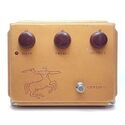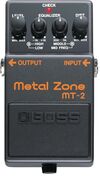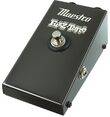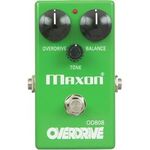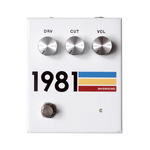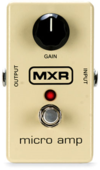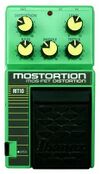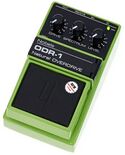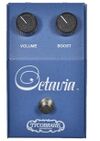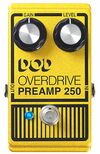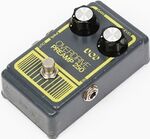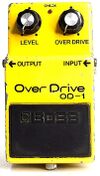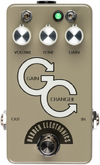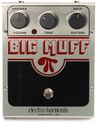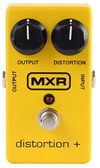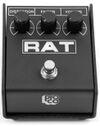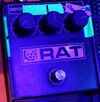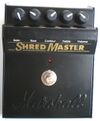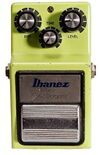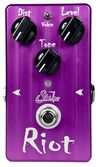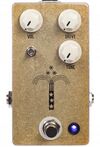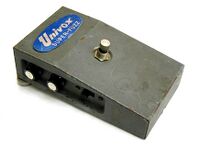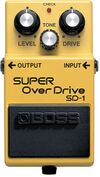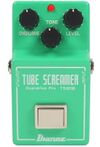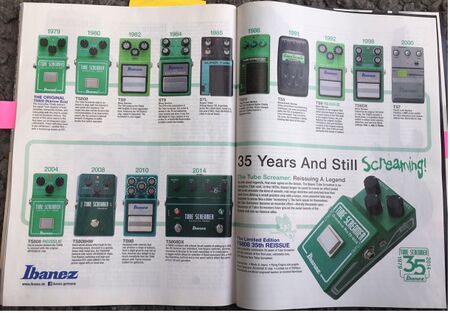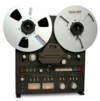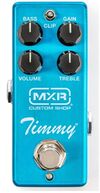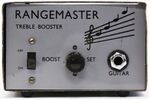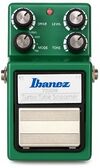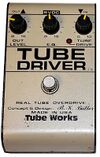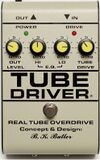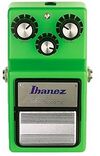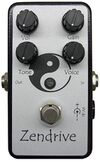This is the wiki for products made by Fractal Audio Systems, maintained by members of the community.
November 2025: the entire wiki has been updated with information about the new AM4 amp modeler.
Drive block
Contents
- 1 Drive block
- 2 About the Drive block
- 3 Drive types
- 4 Overdrive, distortion, fuzz
- 5 Fuzz, buffers and impedance
- 6 Drive controls
- 7 CPU usage
- 8 Input Boost in Amp block
- 9 Parameters
- 10 Tips, tricks and troubleshooting
- 10.1 Yek's Guide to the Fractal Audio Drive models
- 10.2 Electronics
- 10.3 Factory presets
- 10.4 Choose and tweak
- 10.5 Tighten the sound
- 10.6 Turn Amp into Drive
- 10.7 Turn Drive into Amp
- 10.8 Add gain to high notes
- 10.9 Disable diode clipping
- 10.10 Warm up or soften a synth
- 10.11 Tape Distortion for vintage flavor
- 10.12 Distortion from the Cab block
- 10.13 Dynamic Distortion block
- 10.14 Stack multiple drives
- 10.15 Ring modulator into fuzz
- 10.16 Clone other pedals and devices
- 10.17 PEQ instead of Drive
- 11 Drive models
- 11.1 77 CUSTOM OD (MXR M77 Custom Badass Modified O.D.)
- 11.2 ANGRY CHUCK (JHS Angry Charlie V3)
- 11.3 BB PRE (Xotic BB preamp)
- 11.4 BB PRE AT (Xotic BB preamp AT)
- 11.5 BENDER FUZZ (Sola Sound / Vox Tone Bender)
- 11.6 BIT CRUSHER (custom model)
- 11.7 BLACKGLASS 7K (Darkglass Microtubes B7K)
- 11.8 BLUES OD (Marshall Bluesbreaker Mk1)
- 11.9 BOSOM BOOST (Friedman Buxom Boost)
- 11.10 BOX O'CRUNCH (MI Audio Crunch Box V1)
- 11.11 COLORTONE BOOSTER (Colorsound Power Boost)
- 11.12 COLORTONE OD (Colorsound Overdriver)
- 11.13 COMPULSION DISTORTION HP (Fulltone OCD)
- 11.14 COMPULSION DISTORTION LP (Fulltone OCD)
- 11.15 DS1 DISTORTION (BOSS DS-1 Distortion)
- 11.16 DS1 DISTORTION MOD (modded BOSS DS-1 Distortion)
- 11.17 ESOTERIC ACB (Xotic AC Booster)
- 11.18 ESOTERIC BASS RCB (Xotic Bass RC Booster)
- 11.19 ESOTERIC RCB (Xotic RC Booster v1)
- 11.20 ETERNAL LOVE (Lovepedal Eternity)
- 11.21 FACE FUZZ (Dallas-Arbiter Fuzz Face)
- 11.22 FAS BOOST (custom model)
- 11.23 FAS LED-DRIVE (custom model)
- 11.24 FAT RAT (modded Pro Co RAT with LED clipping)
- 11.25 FET BOOST (custom model)
- 11.26 FET PREAMP (possibly based on the BOSS FA-1 FET Amplifier)
- 11.27 FULL OD (Fulltone Full-Drive 2)
- 11.28 GAUSS DRIVE (Mesa Flux-Drive)
- 11.29 GRIDDLE CAKE (Crowther Hot Cake)
- 11.30 GUARDIAN PHOTON SPEED (Greer Lightspeed)
- 11.31 HARD FUZZ (custom model)
- 11.32 HEARTPEDAL 11 (Lovepedal OD11 / Amp Eleven)
- 11.33 HOODOO DRIVE (Voodoo Lab Overdrive)
- 11.34 HORIZON PRECISION DRIVE (Horizon Devices Precision Drive)
- 11.35 INTEGRAL PRE (TC Electronics Integrated Preamp)
- 11.36 JAM RAY (Venuram Jan Ray)
- 11.37 KLONE CHIRON (Klon Centaur / KTR)
- 11.38 M-ZONE DISTORTION (BOSS MT-2 Metal Zone)
- 11.39 MASTER FUZZ (Gibson Maestro Fuzz-Tone FZ-1A)
- 11.40 MAXOFF 808 (Maxon OD-808)
- 11.41 MCMLXXXI DRV (1981 Inventions DRV)
- 11.42 MICRO BOOST (MXR Micro Amp)
- 11.43 MID BOOST (custom model)
- 11.44 MOSFET DISTORTION (Ibanez MT10 Mostortion)
- 11.45 NO-AMP BASS DI (Tech 21 NYC Sansamp Bass Driver DI)
- 11.46 NO-AMP BASS PRE (Tech 21 Sansamp SansAmp BassDriver DI)
- 11.47 NOBELLIUM OVD-1 (Nobels ODR-1 BC Natural Overdrive)
- 11.48 OCTAVE DISTORTION (Tycobrahe Octavia)
- 11.49 OD 250 (DOD Overdrive Preamp 250: reissue)
- 11.50 OD 250 GRAY (DOD Overdrive Preamp 250: original)
- 11.51 OD-ONE OVERDRIVE (BOSS OD-1 Over Drive)
- 11.52 PARADIGM SHIFTER (Barber Electronics Gain Changer)
- 11.53 PI FUZZ (Electro-Harmonix Big Muff Pi, current)
- 11.54 PI FUZZ - BASS (Electro-Harmonix Deluxe Bass Big Muff)
- 11.55 PI FUZZ - TRIANGLE (Electro-Harmonix 1971 Big Muff Pi Triangle)
- 11.56 PI FUZZ - RAM'S HEAD (Electro-Harmonix '70s Big Muff Pi Ram's Head)
- 11.57 PI FUZZ - RUSSIAN (Electro-Harmonix Russian Big Muff Pi)
- 11.58 PLUS DISTORTION (Distortion +)
- 11.59 RAT DISTORTION (Pro Co RAT)
- 11.60 ROYAL BASS DI (Noble Bass Preamp DI)
- 11.61 SDD PREAMP (Korg SDD-3000 preamp)
- 11.62 SHIMMER DRIVE (custom model)
- 11.63 SHRED DISTORTION (Marshall Shredmaster)
- 11.64 SONIC DRIVE (Maxon/Ibanez SD-9 Sonic Distortion)
- 11.65 SUHR RIOT GE (R) (Suhr Riot)
- 11.66 SUHR RIOT LED (L) (Suhr Riot)
- 11.67 SUHR RIOT LED/SI (M) (Suhr Riot)
- 11.68 SUNRISE SPLENDOR (JHS Pedals Morning Glory V4)
- 11.69 SUNRISE SPLENDOR HI-CUT
- 11.70 SUPER FUZZ (Univox Super-Fuzz)
- 11.71 SUPER OD (BOSS SD-1 Super OverDrive)
- 11.72 T808 OD (Ibanez TS-808 Tube Screamer)
- 11.73 T808 MOD (modded Ibanez TS-808 Tube Screamer)
- 11.74 TAPE DISTORTION (tape distortion)
- 11.75 TIMOTHY DOWN (Paul Cochrane Timmy V4)
- 11.76 TIMOTHY MID (Paul Cochrane Timmy V4)
- 11.77 TIMOTHY UP (Paul Cochrane Timmy V4)
- 11.78 TONE OF KINGS (Analog Man King of Tone)
- 11.79 TREBLE BOOST (silicon treble booster circuit)
- 11.80 TS9DX + (Ibanez TS9DX Turbo Tube Screamer)
- 11.81 TS9DX HOT (Ibanez TS9DX Turbo Tube Screamer)
- 11.82 TUBE DRIVE 3-KNOB (Butler Tube Driver)
- 11.83 TUBE DRIVE 4-KNOB (Butler Tube Driver)
- 11.84 TUBE DRIVE 5-KNOB (Butler Tube Driver / Dean Markley Overlord)
- 11.85 VALVE SCREAMER VS9 (Ibanez TS9 Tube Screamer)
- 11.86 ZEN MASTER (Hermida Zendrive)
- 12 Videos
Drive block
Axe-Fx III — 4 blocks, 4 channels
FM9 — 3 blocks, 4 channels
FM3 — 2 blocks, 4 channels
AM4 — 2 blocks, 4 channels
VP4 — 4 blocks, 4 channels
Axe-Fx II, AX8, FX8 — 2 blocks, X/Y
About the Drive block
From Axe-Fx 2 to Axe-Fx 3
FRACTAL AUDIO QUOTES
[1] The drive block in the III uses a higher oversampling ratio and double-precision filters in some places compared to the II.
SPICE simulation
FRACTAL AUDIO QUOTES
[2] New Drive block algorithm (FASPICE) implemented and working.
[3] I've "cracked the code" on drive pedals and figured out a way to do a SPICE simulation in real time without using gobs of CPU. It's so simple I can't believe no one ever thought of it before but none of the papers even approach anything resembling the technique. This will bring "Ares" level modeling to the Drive block.
[4] This algorithm applies to a particular set of circuits that incorporate diodes as a nonlinear component. SPICE modeling is particularly slow when modeling diodes due to convergence issues. However the diodes in drive pedals are used in such a way that there's a trick that can be employed to dramatically decrease the amount of CPU needed to simulate the circuit.
[5] It normally takes a lot of CPU power to do a real-time simulation. The amp block uses an entire dedicated DSP. To do even a simple distortion pedal would normally require huge amounts of CPU. But I stumbled upon a simple trick that reduces it dramatically.
[6] See the two diodes, D1 and D2? The type and quantity of these diodes (among other things that I can't reveal) affect the tone. D1 is the "negative" diode. It conducts when the voltage is negative. D2 is the "positive" diode. It conducts when the voltage is positive. In this schematic the diodes are listed as 1N34A but in the original Distortion+ they were actually 1N270. If you select the Plus Dist model and go to the last page in the UI you'll see the type of diode is 1N270. You can change the type and quantity which will change the distortion characteristics.
1N270 and 1N34A are Germanium diodes. They have a greater reverse saturation current (Is) and, hence, a lower forward voltage for a given current. This means they clip sooner. Silicon diodes, i.e. 1N4148, 1N916, etc. have a lower Is and a greater forward voltage. LEDs have yet a greater forward voltage (smaller Is).
This new firmware has 16 diode SPICE models that I collected from various sources that you can play with. 1N914 are often substituted for 1N4148 and vice-versa but they are slightly different so I included both. The original Tube Screamer had 1S1588 which, to my ears, are much different (better) sounding than 1N914 which are used in the newer Tube Screamers.
[7] Firmware 10 uses new "FASPICE XD" modeling in the amp and drive block. It requires a bit more CPU but the accuracy is far better. I figured out a way to ensure that transcendental equations are always stiffly stable and converge in a fixed amount of time. Significantly faster and at least as accurate as trapezoidal, modified trap, gear, etc. algorithms. It dampens numerical ringing without the side-effect of damping actual circuit ringing. Once you see how it works it seems hard to believe that no one has thought of it before but I can't find a single paper or article that uses the technique. The only drawback is that frequency response is limited to about 1/2 Nyquist but since we oversample that's irrelevant. So that's why you get the "amp feels like it's going to explode" but without the noise and artifacts.
For reference, Wikipedia's SPICE
article says:
SPICE ("Simulation Program with Integrated Circuit Emphasis") is a general-purpose, open-source analog electronic circuit simulator. It is a program used in integrated circuit and board-level design to check the integrity of circuit designs and to predict circuit behavior.
Oversampling
The Axe-Fx III lets you set the oversampling mode for Amp and Drive blocks through the Oversampling Mode parameter in SETUP.
Read Latency and oversampling for more information.
Polarity
FRACTAL AUDIO QUOTES
[8] None of our effects ever invert the polarity of the signal as this will cause issues when running chains in parallel.
Mono
The output of the Drive block is always mono. It will also sum an incoming stereo signal to mono, so watch out for phase issues.
Latency
See Latency for more information.
Drive types
Per category
Clean boost
Bosom Boost • Esoteric RCB • Esoteric Bass RCB • Eternal Love • FET Boost • FET Preamp • Guardian Photon Speed • Integral Pre • Micro Boost • SDD Preamp • Timothy
Bass
Blackglass 7K • Bender Fuzz • Compulsion Distortion • Esoteric Bass RCB • M-Zone • PI Fuzz
Fuzz
Bender Fuzz • Colortone OD • Colortone Booster • Face Fuzz • Griddle Cake • Hard Fuzz • Master Fuzz • Octavia Distortion • PI Fuzz • Sonic Drive • Super Fuzz
Amp-in-a-box, overdrive, distortion
77 Custom OD • Angry Chuck • BB Pre (AT) • Blues OD • Box o’Crunch • Compulsion Distortion • DS1 Distortion • DS1 Distortion Mod • Esoteric ACB • Eternal Love • FAS Boost • FAS LED-Drive • Fat Rat • Full OD • Gauss Drive • Griddle Cake • Guardian Photon Speed • Heartpedal 11 • Hoodoo Drive • Horizon Precision Drive • Jam Ray • Klone Chiron • Maxoff 808 • MCMLXXXI Drv • M-Zone Distortion • MOSFET Distortion • Nobelium OVD-1 • OD 250 • OD-One Overdrive • Paradigm Shifter • Plus Distortion • Rat Distortion • SDD Preamp • Shimmer Drive • Shred Distortion • Sonic Drive • Suhr Riot • Sunrise Splendor • Super OD • T808 Mod • T808 OD • TS9DX • Timothy • Tone of Kings • Tube Drive • Valve Screamer VS9 • Zen Master
Metal
M-Zone Distortion • Shred Distortion
Other
Bit Crusher • Mid Boost • Octavia Distortion • Tape Distortion • Treble Boost
Per clip type
Diodes, Op-Amp
77 Custom OD • BB Pre (AT) • Blues OD • DS1 Distortion • DS1 Distortion Mod • Esoteric ACB • Esoteric RCB • Eternal Love • FAS Boost • FAS LED-Drive • Fat Rat • Full OD • Gauss Drive • Guardian Photon Speed • Heartpedal 11 • Hoodoo Drive • Horizon Precision Drive • Jam Ray • Klone Chiron • Maxoff 808 • MCMLXXXI Drv • M-Zone Distortion • Micro Boost • MOSFET Distortion • Nobelium OVD-1 • OD 250 • OD-One Overdrive • Paradigm Shifter • PI Fuzz (all) • Plus Distortion • Rat Distortion • SDD Preamp • Shred Distortion • Sonic Drive • Suhr Riot Ge and LED/Si • Sunrise Splendor • Super OD • T808 Mod • T808 OD • TS9DX + • Timothy (all) • Tone of Kings • Valve Screamer VS9 • Zen Master
FET
Compulsion Distortion • Fat Rat • FET Boost • FET Preamp
Germanium
Face Fuzz • Master Fuzz
Hard
Bender Fuzz • Hard Fuzz
LED
Angry Chuck • Box o’Crunch • Esoteric Bass RCB • FAS LED-Drive • Fat Rat • Suhr Riot LED • Suhr Riot LED/Si • TS9DX Hot
Silicon
Bit Crusher • Colortone OD • Colortone Booster • Mid Boost • Shimmer Drive • Tape Distortion • Treble Boost
Tube
Tube Drive (all)
Other
Blackglass 7K • Bosom Boost • Griddle Cake • Integral Pre • Octave Distortion • Super Fuzz
Overdrive, distortion, fuzz
Transistors in electronical devices amplify the signal and when they clip, they distort. The type of clipping determines how the pedal sounds and how it is categorized.
- Overdrive pedal
- Based on soft gradual clipping, reacts dynamically and usually is aimed at complementing or replicating the sound of a driven amplifier.
- Fuzz
- Clips hard and aggressive and creates a buzzy sound, like something’s broken. Also, a fuzz depends on the impedance of the signal.
- Distortion
- Covers the middle ground, leaning towards higher gain instead of overdrive.
See these references for additional information:
- Reverb's
The Difference Between Fuzz, Overdrive and Distortion
article - Pete Thorn shows
How To- And How NOT To- Use Overdrives And Distortions, Tone Secrets
in Part 1 and Part 2 - Ultimate Guitar's
Brief History of Fuzz
andThis is the Difference Between Overdrive, Distortion and Fuzz
- Rhett Shull's video
How to REALLY Use Overdrive (like the PROs)
- JHS's
The Origin of Fuzz
andHistory Of Guitar Distortion
,Understand The Types Of Overdrive Pedals On The Market
andHow To Find the Fuzz Pedal You Need
videos - Wampler's
OverDrive vs Distortion vs Fuzz
andHow do the various clipping circuits work?
videos - Dave Hunter:
The Big Buzz – Origins of the Fuzz Box & Tips on Getting Fuzzy
If you have Apple TV+, watch the Watch the Sound
series episode about distortion.
Fuzz, buffers and impedance
Most fuzz pedals depend on a direct connection between the guitar pickup and the input of the pedal. A modeler gets in the way because its input is always buffered (inherent to the architecture), causing a modeled fuzz to react differently than the actual pedal. This is demonstrated in Wampler Pedals' video Do Fuzz Pedals sound better in a clean or dirty amp?
To improve the emulation of such fuzz boxes, the Axe-Fx series, FM9, VP4, AM4 and FX8 allow a specific input impedance setting or an Auto
setting. The AX8 and FM3 do not have this feature. When creating a fuzz-specific preset, experiment with the Impedance parameter in the Input block. Important: the Auto
setting only works if the Drive model is the first non-bypassed block after the Input block in the SAME row or below.
Read Input impedance
for more information.
Forum member AustinBuddy recommends setting Input Impedance to 90K in presets which have a fuzz model as the very first (non-bypassed) block. This doesn't apply to devices with fixed input impedance.
Wampler's EQ trick with buffered fuzzes
FRACTAL AUDIO QUOTES
[9] […] The Fuzz in the Axe-Fx reacts as though there is a buffer in front of it (because there is). It's a limitation inherent to all modeling products. I modeled it using a nominal source resistance. I forget what I used for the source resistance but it was probably around 100K ohms. To really simulate it you would need a controller to simulate the changing output impedance of the guitar.
[10] You can simulate the effect of a guitar into a Fuzz-Face using the Input-Z feature.
[11] The problem is that the signal is buffered and there is no way to model the interaction of the pickups with the circuit.
[12] It's impossible to get a buffered device (like a multi-effect) to replicate fuzz pedals because the input impedance of a fuzz pedal is nonlinear. You can get close by using a static input resistance at the input to the device but it will never be exactly the same.
Duplicating the behavior of a fuzz pedal requires that the pedal be the first non-bypassed block following the Input 1 block and the input block impedance must be set to Auto since fuzz pedals load down the guitar’s pickups.
[13] The one thing no modeler will ever get perfect are fuzz pedals because of the interaction between the pickups and the pedal. The input to a modeler is necessarily buffered so that interaction is impossible to recreate.
The reason it was not included in the FM3 was cost and space.
[14] No digital device will do a fuzz properly because the input impedance is nonlinear. Digital devices necessarily have an input buffer. I will say our conventional, buffered, drive models are great.
Drive controls
The controls on the Basic page of the Drive correspond with the knobs on the modeled devices.
FRACTAL AUDIO QUOTES
[15] The Tone control works the same as the modeled pedal.
[16] The model's controls replicate the actual pedal.
[17] Note that potentiometer tolerances can be as much as +/-20%. That means the real pedal on 5 could be equivalent to the model anywhere between 4 and 6. The same applies to the Tone and Level controls. The roll off the volume test is a good way to match the gain. Roll off the volume and if the model has less gain increase the gain control and vice-versa.
CPU usage
Drive models use varying amounts of CPU. In the Axe-Fx II, AX8 and FX8, this was amplitude-dependent,meaning that CPU usage rises and fluctuates when playing. This does not apply to the current generation, except for the AM4.
The table below shows the CPU usage of the Drive models in the Axe-Fx III (non-Turbo) in firmware 17 for the Axe-Fx III (empty preset). The types that use the most power are diode-based.
2% to 4%
Bender Fuzz • Bit Crusher • Blackglass 7K • Bosom Boost • FET Boost • FET Preamp • Face Fuzz • Hard Fuzz • Integrated Pre • Master Fuzz • Micro Boost • Mid Boost • Octave Distortion • PI Fuzz • SDD Preamp • Shimmer Drive • Tape Distortion • Treble Boost • Tube Drive (all)
8% to 9%
BB Pre • BB Pre AT • Blues OD • Box o’Crunch • Compulsion Distortion (all) • DS1 Distortion (all) • Esoteric ACB • Esoteric RCB • Esoteric Bass RCB • Eternal Love • FAS Boost • FAS LED-Drive • Rat • Full OD • Heartpedal 11 • Hoodoo Drive • Horizon Precision Drive • Jam Ray • Klone Chiron • M-Zone Distortion • Maxoff 808 • MCMLXXXI Drv • OD 250 (all) • Plus Distortion • Rat Distortion • Shred Distortion • Sonic Drive • Suhr Riot (all) • Super OD • T808 (all) • Timothy (all) • Tone of Kings • TS9DX (all) • Valve Screamer VS9 • Zen Master
Input Boost in Amp block
The Amp block includes an Input Boost option. This feature allows boosting an Amp model without requiring an additional Drive block, resulting in less overall CPU usage. A selection of Drive models, including T808, T808 Mod, Super OD, Full OD, AC Boost, Shimmer, FAS Boost, Treble Boost, Mid Boost and RCB Boost, is available. These boosts are NOT 100% equivalents of the Drive block. Instead, they act as clean boosts, replicating the oft used Drive on 0, adjust Level as desired
boost technique. They do not include the clipping gain of the Drive block types, just the EQ curves.
Some Input Boost types are available in the Amp block only, with no Drive block equivalent, such as Neutral, Grinder, CC Boost and Shred Boost.
The Boost Level parameter controls the amount of boost, up to 24dB.
Read Input Boost
for more information.
Parameters
Mix
Unlike other effect blocks, 0% Mix in a Drive block is not equivalent to 100% dry signal passing through ("true bypass"), because clean level can still pass through the virtual diodes (controlled by the Dry Level parameter).
FRACTAL AUDIO QUOTES
[18] The models let clean through even with the mix at 100%. It depends on the diodes though as to how much clean is mixed. Our models are based on the most common versions.
[19] The mix control in the Drive block controls the ratio of clean to dirty in the distortion stage. It's not the same as the standard mix control in the other effects.
The Mix parameter operates prior to any tone control. This lets you mix dry signal with the distorted signal and still maintain overall tone control. Some users lower Mix to increase transparency and attack.
Dry Level
The Dry Level parameter in diode/opamp-based drive types (current firmware) determines the amount of clean level that passes through the diodes. Said differently, it controls the amount of “dry” signal mixed with the “wet” (distorted) signal. For a Tube Screamer-based model this will default to 100% due to the topology. For other types this will default to 0. Values up to 200% are allowed. Note that the dry data is added before any tone controls and therefore is not exactly equivalent to a mix but rather replicates the behavior of analog circuits.
From the Axe-FX III v3.02 firmware update release notes
[20] If the Dry level defaults to 100% then it's a Tube Screamer derivative. Tube Screamers use a non-inverting op-amp configuration with diodes in the feedback loop. This results in a transfer function that is Y = X + f(X) where f(X) is the distortion response. IOW they mix the dry signal with a distorted signal.
Bass Response, Low Cut
(firmware 13) The “Bass Response” control exists for types based on the Rat, Tube Screamer and various derivates. In some models this is duplicated on the Basic page as it is the Bass/Voice/etc. control. This function was previously provided by the Low Cut control. The Low Cut control is now a separate control that allows adjusting the input highpass frequency.
Low Cut is pre-gain. High Cut is post gain.
Sample Rate
Use Sample Rate Reduction to intentionally allow aliasing, for creative effects.
Tip: assign the parameter to an expression pedal.
Bit Reduce
This intentionally lowers the resolution of the signal (lo-fi
).
Slew
This probably refers to how fast the circuit can swing its output. If the signal to be amplified is too fast, the circuit will not be able to perform properly, only amplifying signals below the slew rate limit. Poor slew rate results in high frequencies not passing through the amplifier, and thereby limiting or muting high harmonics.
The Pro Co RAT is known for its poor slew rate, because of the LM308 op-amp being used. See the ElectroSmash analysis in Pro Co Rat Analysi
.
From Wikipedia's Slew Rate
article:
In electronic musical instruments, slew circuitry or software-generated slew functions are used deliberately to provide a portamento (also called glide or lag) feature, where an initial digital value or analog control voltage is slowly transitioned to a new value over a period of time (see interpolation).
Slew-induced distortion (SID or slew-rate induced distortion) is caused when an amplifier or transducer is required to change output (or displacement), i.e. slew rate, faster than it is able to do so without error. At such times any other signals may suffer considerable gain distortion, leading to intermodulation distortion. Transient intermodulation distortion may involve some degree of SID and/or distortion due to peak compression.
From Wikipedia's Slew-induced distortion
article:
Slew-induced distortion (SID or slew-rate induced distortion) is caused when an amplifier or transducer is required to change output (or displacement), i.e. slew rate, faster than it is able to do so without error. At such times any other signals may suffer considerable gain distortion, leading to intermodulation distortion.[1] Transient intermodulation distortion may involve some degree of SID and/or distortion due to peak compression.
Firmware Ares 10.01 for the Axe-Fx III:
Changed Drive block Slew Limit to Slew Rate and updated default value of the models. Existing presets will be updated to the new default value upon recall. Note that the parameter now controls the slew rate and lower values equal less high frequency response at high amplitudes and vice-versa (the action is reversed from the previous firmware versions).
Graphic EQ
The EQ can be placed either PRE or POST distortion.
The EQ is reset when changing the Drive type.
Tips, tricks and troubleshooting
Yek's Guide to the Fractal Audio Drive models
Forum member Yek (Alexander van Engelen) discusses the Drive models in his "Guide to the Fractal Audio Drive Models" (PDF file).
The guide was preceded by threads on Fractal Audio's User Forum.
There are two versions of the guide:
- July 2022, for Axe-Fx III, FM9 and FM3
- November 2018, for Axe-Fx III prior to firmware 3.02, and Axe-Fx II, FX8, AX8
Yek stopped updating the PDF guide after 2022 and ported the contents to this wiki page.
Electronics
Partly derived from the book Pedal Crush – Stompbox Effects For Creative Music Making
:
A transistor is a semiconductor that amplifies the input signal and can clip the signal into distortion. It’s a compact alternative to vacuum tubes. Early germanium transistors were very unreliable. Silicon transistors provide more reliable and consistent performance.
A capacitator stores electrical energy and used for various purposes such as filtering frequencies or blocking interference.
A resistor reduces current flow and it used to control signal levels, voltage etc.
A diode is a non-amplifying semiconductor that can clip the signal into distortion. Low-gain germanium diodes have a softer and woolly sound, silicon diodes generate higher gain and hard clipping.
Besides performing as on/off lights, LEDs are diodes that can clip the signal. Every color has different characteristics.
An inductor is a coil of wire that creates a magnetic field. Used in Wah pedals to voice the effect.
An IC is an Integrated Circuit (chip) that contains transistors, resistors, capacitators etc.
An op-amp, AKA Operational Amplifier
is an IC that's capable of louder clean amplification than a transistor, using diodes to clip the signal into distortion when needed.
These YouTube videos have more information:
- 1970’s Op-Amp Distortion (JHS)
- Busting the myth of magic op-amps and diodes? (Wampler)
- What do all the parts do on a guitar pedal? (Wampler)
- Transistors Explained (The Engineering Mindset)
- Diode-Based Overdrive and Distortion Effects
Factory presets
Many factory presets contain one or more Drive blocks. Search the Factory presets page.
Choose and tweak
The sound of a drive type depends heavily on the chain, starting with the guitar and pickup. The type of amp and cabinet and amount of amp gain matter too. Fender amplifiers and Tube Screamer match so well because the pedal’s mid hump compensates for the mid-scooped frequency curve of these amplifiers. A RAT sounds better through a VOX than a Fender. A Fuzz Face sounds great through a Marshall because those amplifiers can manage the bass overload from the pedal. Some drives are designed to tighten up high gain amplifiers, some drives are meant to turn clean amps into blazing metal monsters, etc.
Depending on the Drive type, controls may do nothing or are highly sensitive. Always explore their entire range and their interaction. Examples:
- A low Drive setting with a high Level setting may sound better than just cranking Drive.
- A Bass or Treble control may need to be set to an extreme setting instead of just noon, because its acts as a “cut” control.
Tighten the sound
A Drive block before the Amp block, with minimal gain, will tighten the low end of dirty amp tones. It also allows turning down gain in the Amp block. This works well in particular with Tube Screamer-based Drive types.
Alternatively, use a PEQ block, set to Blocking, and copy-and-paste High Cut and Low Cut values from a favorite Drive type. This will apply the same coloring as the drive, without the gain and CPU usage.
Alternatively, use the Input Boost in the Amp block itself, see above.
Turn Amp into Drive
Some manufacturers of guitar amplifiers build pedals that sound like their signature amplifiers, such as EVH 5150, Friedman BE-OD, Bogner Ecstasy Blue and Red, Bogner Uberschall, Diezel Zerrer. You can accomplish a similar thing in Fractal Audio’s modelers by changing an Amp model into a Drive model.
It's a simple procedure, simply turn off Power Amp Modeling in the amp block. Current firmware provides a switch for this and expands the inventory of drives and requires less CPU usage than a dedicated Drive block. It’s especially handy in the Axe-Fx series and FM9 with their dual amp blocks. AX8 and FM3 owners can take advantage of this as well, in combination with a real amp.
More information is in:
- The forum
Want the MXR 5150 Overdrive pedal? You got it already.
discussion - Leon Todd's video tutorial
Using Amps as Drives
This is something done with real amps too. Randy Bachman used a similar trick with his amplifiers; “The Audience Was Going Nuts. They Could Feel the Electricity Happening”: Randy Bachman Reveals How a Broken Guitar String Led to the Guess Who’s 1970 Smash “American Woman”
I got the sound with my Les Paul plugged into what I called the Herzog: two Garnet amps made by [Garnet founder] Gar Gillies, with one used as a preamp.
Turn Drive into Amp
With some creativity, you can replace an Amp block with a Drive block. It will not sound fantastic, and it will lack dynamics, but it lets you bypass the single amp block limitation of the AX8 and FM3.
Add gain to high notes
Attach Pitch (internal controller) to the Drive parameter and use Slope in the modifier menu to fine-tune. This will increase or lower gain depending on the pitch of the played note. Finetune the modifier settings for precise control.
More information is in:
- hippietim's comment in
Quick first impressions of the Axe-Fx III
in the forum - Leon Todd's
5 Minute Tones - The Pitch Follower Modifier
video tutorial
The factory preset Pitch Follower
demonstrates this.
Disable diode clipping
To disable diode clipping, set Diode Quantity to 4 and select one of the LED types. [21]
Warm up or soften a synth
A Drive type, especially the RAT, can be put before a Synth block to warm up or soften the synth sound.
Tape Distortion for vintage flavor
The Tape Distortion type, either before or after the Amp block, can add a vintage flavor to the sound.
Distortion from the Cab block
The Cab block's Preamp page provides tools to simulate clipping from mic preamps, channel strips and tape.
Dynamic Distortion block
Read Dynamic Distortion block
for more information.
Stack multiple drives
Multiple drives can be stacked. Examples:
- two T808s (like SRV)
- two Face Fuzz models
- Octave Distortion followed by Face Fuzz
- Face Fuzz followed by Treble Booster
Ring modulator into fuzz
Put a tracking ring modulator before a fuzz. Example: Ring Fuzz
scene in the BLANKENSHIP LEEDS
factory preset.
Clone other pedals and devices
Note: because of ever evolving firmware, suggested settings in the links below may not be accurate anymore.
- EHX Soul Food
- AA Workhorse
- Solo Dallas Schaffer Replica pedal, more information
- Xotic EP Booster
- Roger Mayer Axis Fuzz
- Boss HM-2
- Cornish SS2
- JHS Superbolt
- Mesa Grid Slammer
PEQ instead of Drive
A PEQ block can deliver the characteristic EQ curve of a drive pedal without its gain or sculpt the soul of an Amp model.
To get that ‘80s nasal hard rock tone: put a Peaking PEQ before a Plexi amp model, and add 5 to 7dB at 1000 Hz.
To approach the sound of a Klon try these settings:
- band 1 Shelving2, 150 Hz, 0.707, -12
- band 5 Shelving2, 2253 Hz, 0.707, -12, Level 1.5
Drive models
Leon Todd demonstrates various Drive types in FM3 3.03b - New Drives, UltraRes IR's & More
.
The following is a list of Fractal Audio's Drive models and the original devices on which these are based.
VP4: the list of drives on the VP4 is shorter because some drive models on the VP4 are consolidated.
77 CUSTOM OD (MXR M77 Custom Badass Modified O.D.)
From MXR'S Custom Badass Series, a classic overdrive circuit that's been upgraded with a 100HZ control and a Bump switch for improved performance and versatility.
The sound was similar to an SD-1.
Controls: Tone, Output, 100HZ cut/boost, Gain and Bump switch (alternate EQ voicing that boosts the lows and mids, like a Tube Screamer).
MXR • Audiofanzine • Prymaxe • Boss SD-1 vs MXR M77
ANGRY CHUCK (JHS Angry Charlie V3)
This pedal/model aims to produce the sound of a Marshall JCM800, a so-called amp-in-a-box. The jury is still out to decide if the pedal's sound really compares to a JCM800, but it's a popular pedal anyway.
Andy Timmons used to use one to get his overdriven aggressive sounds. Later he worked with JHS Pedals to create his signature AT overdrive pedal, which is based on the Angry Charlie circuit.
Fractal Audio modeled the red V3 version, which added the three-band tone stack and U-shaped knob layout and has a little more headroom.
"The Angry Charlie has become a staple of the JHS line over the years, and it’s a force to be reckoned with in the high-gain pedal territory. Its ability to convincingly and accurately breathe JCM800 tones into any rig has made it a popular choice for guitarists of all genres. And unlike many other British amp-in-a-box pedals, the Angry Charlie V3 sports a 3-band tone stack, just like the Marshalls, helping nail those warm yet searing tones and boundless sustain. If you are a glutton for high-gain overdrive/distortion that has a British flavor, the Angry Charlie V3 will change your life. Well, your gear life." JHS
"A drive pedal that is marketed as sounding like a JCM800 but is really just another MI Audio Crunchbox / Suhr Riot / etc. derivative which can all trace their lineage back to the Marshall Bluesbreaker." Fractal Audio
Controls are Drive, Volume, Bass, Middle and Treble. The tone controls are active. According to JHS, Drive and Volume control interact the same as a master volume amp head.
At low gain settings, the sound is a bit bluesy. Turn it up and it becomes aggressive.
JHS• Riffs, Beards & Gear • That Pedal Show • gearmanndude • Martial Allart
BB PRE (Xotic BB preamp)
Xotic is an American company known for its quality effects, such as the BB preamp, RC Booster, AC Booster, EP Booster and Robotalk, as well as its guitars and basses. Some say “BB” is an abbreviation of “Bluesbreaker”, Marshall’s vintage 2x12 combo amp, used by Eric Clapton in John Mayall’s Bluesbreakers (read more about it in Yeks Guide to the Fractal Audio Amp Models. But it doesn't sound like it is. Others say it means “Big British”. It's a diode-based pedal with a preamp gain stage that can turn a pristine clean amp into a well-behaved overdriven version. It also smoothens and compresses an already overdriven tone. While the pedal doesn’t sound like a Tube Screamer (there’s no mid-hump) and has much more gain, it is partly based on that circuit. Like all drive types, its sound depends on the amp it’s being used with. The pedal gained popularity after Andy Timmons made it his main boost pedal (before switching to MI Audio and JHS). Xotic built him a signature edition. Xotic released several versions of the pedal, with varying amounts of compression as described on Guitar Tone Overload. The pedal is still being manufactured (version 1.5, $170) and remains a popular choice. Around 2017 Xotic reissued an earlier version of the pedal (limited edition), named BB preamp AT (AT = Andy Timmons).
"The BB Preamp offers a wide variety of sounds. It’s capable of a 30dB+ clean boost with an adjustable ±15dB two band active EQ which adds a wide range of harmonic content to your ideal sound. The BB also utilizes a pre-gain stage which allows the pedal to go from a very pristine clean to a very smooth, compressed, overdriven sound." Xotic
The pedal has Gain, Volume, Bass and Treble knobs. The tone controls are active, cutting or boosting up to 15dB.
Fractal Audio provides two models. One is based on the BB preamp 1.5. The other one on the BB preamp AT.
"The BB is more of a clean boost it's just pushing the amp (model)." Fractal Audio
At default settings into a clean amp, the models replicate an overdriven amp. A moderate Drive setting works well for the amp-in-a-box sound. Set Gain close to 0 and turn up Level to tighten an already overdriven amp or boost a clean amp. The model is featured in some factory presets, search this wiki page for “BB Pre”. If you like the character of the BB Pre model, but prefer a thicker type of sound, try the Esoteric ACB model, based on Xotic’s AC Booster pedal (now discontinued).
Andy Timmons • J.D. Simo • Dave Weiner • ProGuitarShop (Strat) • ProGuitarShop (Les Paul) • Sam Vilo • Prymaxe: BB Pre • Prymaxe: BB Pre AT • Guitar Sanctuary Featuring Andy Timmons • D’Addario Sound Advice: Andy Timmons • Mike Hermans: BB Pre AT • The Tone Lounge
BB PRE AT (Xotic BB preamp AT)
See above.
BENDER FUZZ (Sola Sound / Vox Tone Bender)
The classic Tone Bender fuzz originates from the ‘60s and was designed and manufactured by Macari’s / Sola Sound in the UK. The Tone Bender name was used for their series of fuzz boxes. Sola Sound and Vox Tone Benders are basically the same thing because the Sola design was licensed to JMI/Vox. Sola Sound also built the Colorsound range of effects, including the famous wah pedal, the Power Boost and the Overdriver (also provided as models) and several different versions of the Tone Bender. Jimmy Page used a Tone Bender when recording Led Zeppelin’s Whole Lotta Love, as demonstrated in the documentary “It Might Get Loud“. The Beatles, Jeff Beck in The Yardbirds and Eric Clapton have used it too.
According to Wikipedia, the first Tone Bender design (MK1) was based on the Maestro fuzz and contained three transistors. The second edition, later named MK1.5, had two transistors and was a negative feedback amplifier; the Arbiter Fuzz Face and Vox/JMI Tone Bender are based on it. The Professional MKII edition contained three transistors again; it was a MK1.5 model with an additional gain stage, and probably is the most popular and most-copied design. The MKIII (the inspiration for Fulltone’s Soul-Bender) had an additional tone control and was followed by the MKIV. There are many clones on the market. The Colorsound “Supa” Tone Bender (1973) used silicon transistors and was based on the “Ram’s Head” Big Muff.
"The Tone Bender MKI.5 is said to be the first circuit type used in any Sola Sound sand cast enclosure and the only Tone Bender made with two germanium transistors. So sonically what can you expect? The tone is a little heavier and denser when compared to that of the Professional MKII. Has some of that beefy woolliness of a good germanium Fuzz Face but still has enough cut and shove to not completely loose it in the mix. The saturation levels are lower too so works pretty neat for driving a big ballsy amplifier over the edge but never to the extent that things completely fall apart.
Some would say that it all about the place it holds in the world of rock’n’roll. When I demo a MKII in the shop these days I am still blown away by the sound – for me it is the epitome of great guitar tone – loads of headroom, warm fat crunch through to aggressive rock tones suitable for downtuning, then back off your volume and there are all those huge blues tones. That’s today... what it must have been like back in 1964 I can only imagine – It must have been like a spaceship landing – most people walking into Macaris back then would have only heard a fuzzbox on record – this pedal played through an old Marshall or Selmer or Vox – well, for a guitarist, it must have been life changing." Macari's
Many clones and replicas exist. D*A*M Stompboxes still builds authorized authentic reissues. BOSS in collaboration with Sola Sound released the Waza Craft TB-2W Tone Bender, a limited edition reissue of the MK II fuzz-pedaal, which costed over $300 when released, and goes for much higher now.
“The first commercially made fuzz box to hit the UK market was the golden coloured, wedge shaped; three transistorized Gary Hurst designed Tone Bender. The Tone Bender was released in September 1965 and sold for 14 guineas, approximately £185 in today’s worth. The Tone Bender was a big hit and quickly drew big name players to a growing rank of users. The Yardbirds, The Who, The Pretty Things, The Merseybeats, The Ivy League and a rather popular band from Liverpool called the Beatles were among users of the Tone Bender. Guitar player with a Hull based band called the Rats also used this original Tone Bender as his primary fuzz sound for many years. This Guitar player was Mick Ronson who as we know went on to play lead guitar alongside a certain David Bowie. This first incarnation of the Tone Bender was only made for a relativity short time period before the design of the pedal was significantly changed.
Following the success of this first Tone Bender, which we will refer to as the MKI, it was clear that the design of the pedal needed to be geared towards being a more readily produced item. Early in 1966 a new improved Tone Bender arrived on the scene, this version of the Tone Bender has become known as the MKI.5. This new design was much more modern & futuristic in appearance and was also more ergonomic in its aesthetics, more space ship like in appearance than the tank like appearance of the MKI. The new improved Tone Bender enclosure was manufactured using a sand casting process and was finished in a silver/grey hammertone paint. The new Tone Bender was, like its predecessor, named only as a ‘Tone Bender’. The silk screening on the enclosure only featured the pedals name; the labelling for the controls and the input & output sockets, no company information was featured.
The internal construction style of the MKI.5 is of the same style that followed through into the build technique of the MKII’s. The MKI.5 utilised isolated jack sockets as to avoid ground loops, a feature used on all Tone Benders and most other quality British made effect pedals from the 1960’s. A technique unfortunately that is seldom used today. All the early Tone Benders, right up to the introduction of the MKIII, also relied heavily on the use of shielded cabling throughout. Again, a very good construction technique and yet again little seen in use today. Interesting side note, true bypass switching that is often seen as a modern feature to ‘boutique’ builders was actually first seen used in the Tone Bender MKI.
The earliest MKI.5 Tone Bender I seen featured two IMPEX S3-1T Germanium transistors. Possibly have been prototype unit? Commonly the MKI.5 along with a large percentage of MKII Tone Benders used the British made Mullard OC75’s. The two transistor arrangement of this type of circuit is called a voltage feedback biasing circuit. Interestingly, several fuzz boxes that first made their appearance in the year 1966 used this very same set-up. The Arbiter Fuzz Face, the Vox Tone Bender, Vox Distortion Booster and the Sola Sound made Tone Bender MKI.5. Possibly a happy coincidence? But more likely inspired by the popularity of the originator." D*A*M Stompboxes
Tone Bender Timeline • The History of the Great Fuzz Pedals • Premier Guitar's Face the Fuzz: A Beginner’s and Skeptic’s Guide to Fuzz Pedals • Premier Guitar's Fifty Years of Filth: The Story Of The Mighty Bender Fuzz • Rhett Shull: Macari shop story • Brief History of Fuzz • ToneHome
The most popular Tone Bender designs are simple pedals with just two knobs: Attack (amount of fuzz, Drive in the model) and Level.
"The Tonebender has a lot of treble boost. If you're using it with a modern, heavy-sounding amp it will sound like cr*p. It works best with vintage, dark amps like the Class-A. It was originally designed to complement the British amps of that era which were very dark. Put it in front of the Class A model and it sounds killer.” [22]
So. far, it’s unknown which circuit has been modeled by Fractal Audio. But it doesn’t really matter: the Bender Fuzz model sounds great. While real Tone Bender pedals contain germanium transistors, the Clip Type parameter in the model is set to “Hard”, representing the circuit’s hard clipping. It is a versatile fuzz model. It can be used with a clean amp, where it will sound punchy, or with an amp with a lot of power amp distortion (e.g. Plexi), capable of filling the room and flooring the audience, making modern high-gain amps hide sheepishly in a corner. It can even be used with amps with lots of preamp gain, and with bass guitar. At high Drive settings, notes on the low E-string get spitty, like an imminent implosion to happen. Dialing in the model is as simple as putting it before or after a clean or slightly dirty Marshall amp model, turning the Drive control to the desired position, and using the guitar’s volume knob to control the amount of fuzz. Turn up Drive and Level for crushing distortion, reminiscent of Ian Thornley of Big Wreck. For a milder fuzz tone, turn down Drive. For more information about the interaction between the guitar and fuzz models, refer to the notes earlier on this page. The model is featured in some factory presets, search this wiki page for “Bender”.
Sola Sound Tone Bender • Macari’s: Tonebender • Which JMI Tone Bender is Right For Me • MKII Tone Bender • Ramble FX Twin Bender Fuzz (Pete Thorn) • Original 1973 Tone Bender • MKI Tone Bender (British Pedal Company) • MKII Tone Bender (British Pedal Company) • MKI.5 Tone Bender (British Pedal Company) • MKIII Tone Bender (British Pedal Company) • The Best Fuzz Pedal I’ve Ever Played (Rhett Shull) • My Most Valuable Pedals (JHS) • History Of Guitar Distortion (JHS) • 10 Rare Pedals (JHS) • The First Guitar Effects Ever (JHS) • How to Find the Fuzz Pedal You Need (JHS) • Colorsound Supa Tonebender • Is The BOSS Waza Tonebender Worth It? (JHS)
BIT CRUSHER (custom model)
Bit crushing is the process of intentionally downgrading audio quality, to create a warm sound or as an effect by itself. A bit-crushing pedal or software plugin often provides bit reduction and sample rate controls, and more. Fractal Audio’s Bit Crusher model is not modeled after a specific pedal, although such pedals do exist. If you don’t use the model’s bit reduction and sample rate controls, a generic drive remains.
"Based on a black box we found lying in the trash outside Studio Harshclip." Owner's Manual
The model at default settings showcases the Bit Reduce control. In fact, this control appears in every Drive type, so it’s not limited to this specific model. It lets you reduce the resolution (dynamic range) of the digital signal. This creates artifacts, a stair-stepping effect and distortion. Its value is the number of bits that will be subtracted from 24-bit full scale. For example, to create 4-bit audio, set it to 20 (default value in this model). Be aware that bit reduction will introduce background hiss and will cause the signal to drop out. The model already does this at default settings.
“Samples in digital audio are recorded as integers or floating-point (real) numbers stored in computer memory. Those numbers are encoded using a series of on and off memory bits. The larger the number of bits, the more accurately a sample encodes the instantaneous volume level of a sampled audio waveform. DAWs today typically use 32-bit floating-point numbers. Early digital audio gear and video games used 8-bit integer samples or less. Roland's classic TR-909 drum machine used 6-bit integer samples. Resolution reduction intentionally reduces the number of bits used for audio samples. As the bit depth goes down, waveforms become more stair-stepped and subtle volume variations are lost. At extreme bit reduction, waveforms are reduced to clicks as a waveform jumps abruptly from low to high and back again without intervening values.” Wikipedia
Another way to intentionally downgrade signal quality is to use the Sample Rate control. This control also appears in every Drive model. It introduces digital aliasing by reducing the sample rate from 48kHz all the way to 48Hz. This also creates digital artifacts and messes up pitch.
“Digital audio is composed of a rapid series of numeric samples that encode the changing volume of an audio waveform. To accurately represent a smooth waveform, digital audio requires many samples at a high sample rate. The higher the rate, the more accurate the waveform. Higher sample rates also allow higher frequencies to be accurately encoded. DAWs today typically use 44.1 kHz or higher sample rates. Early digital gear used much lower sample rates to conserve memory for stored audio. Sample rate reduction (also called down-sampling) intentionally reduces the sample rate to degrade the quality of the audio. As the sample rate is reduced, waveforms become more coarse and high frequencies are lost. At extreme reductions, the waveform becomes metallic sounding.” Wikipedia
Pedal Crush – Stompbox Effects For Creative Music Making
Tips:
- Run the Looper when experimenting with Bit Reduce and Sample Rate. Record a clip, set it to playback, then go wild with the controls
- Attach the Sequencer (internal controller) to a parameter in the Synth block and run it through the Bit Crusher model
- Attach an expression pedal to Sample Rate
If you like lo-fi sounds, consider these alternatives:
- Lower the low and high sliders in a GEQ block
- Use the IR of a tiny speaker cabinet
- Crank Speaker Drive in the Amp block
- Crank Drive and Saturation in the Cab block’s Preamp simulation
- Use the Ring Modulator block in non-tracking mode
- Use low-pass and high-pass filtering
- Generate pink or white noise with the Synth block
Sample rates: The Higher The Better, Right? • Battle Of The Bitcrushers • BitCrusher III • Red Panda Bitmap
BLACKGLASS 7K (Darkglass Microtubes B7K)
Referred by its manufacturer Darkglass Electronics as the “Black Beast”, this Scandinavian analog bass preamp and overdrive (big brother of the B3K model) is famous for its overdrive, transparency and versatility and is very popular, either as a standalone preamp or as a distortion pedal. It covers the spectrum from crystal clear powerful tones to modern crushing bass distortion.
“Tone crushing overdrive and super transparent modern sound is the essence of the B7K. One of the most acclaimed Darkglass pedals in the bass community, it doesn ́t compromise the original sound of the instrument, but it enhances its presence in the mix.” B7K Manual
“The Microtubes B7K takes the powerful dynamic saturation circuit of the B3K and adds a four-band equalizer and a balanced line driver for even greater versatility. Designed for both studio and live use, it will take your direct sound to a whole new level.” Darkglass
Controls on the original pedal: Blend (mixes clean signal with overdriven signal), Level, Drive and four EQ knobs: Low (100Hz), Low Mids (1 kHz), Hi Mids (2.8 kHz), Treble (5 kHz). The Attack switch controls the amount of treble content to saturate and provides these options:
- Boost: emphasizes treble content
- Flat: neutral
- Cut: de-emphasizes treble content
The Grunt switch controls the amount of low frequency content to saturate before the clipping stage and provides these options:
- Fat
- Thin
- Raw
Fractal Audio’s hard-clipping model is based on the original B7K pedal, not the later Ultra and V2 editions. But because Fractal Audio includes a GEQ in every Drive block, the model already goes beyond the pedal on which it is based. Just like the real thing, Fractal Audio’s model can be used either with and without Amp and/or Cab blocks. According to Fractal Audio, the model has been created with the Attack and Grunt switches in the middle position. The Grunt switch changes the low-cut frequency. The Grunt control in the model is the same as the Low Cut control. The Attack switch controls a shelving filter on the input. Note: early versions of the model were not 100% accurate because of issues with the modeled device.
demo • Darkglass • Chris Kollias • demo • demo
BLUES OD (Marshall Bluesbreaker Mk1)
In the ‘60s, Eric Clapton reportedly played through a very loud Marshall JTM 45 combo when recording John Mayall’s famous “Beano” album. This amp became known as the Bluesbreaker. Read more about it in the Guide to the Fractal Audio Amp Models. In the ‘90s, Marshall released the Bluesbreaker pedal (BB), designed to replicate this sound. It was part of a series that also contained the Shredmaster and the Drivemaster pedals. It’s a light-to-moderate soft-clipping overdrive, totally different from the ubiquitous Tube Screamer sound. The Bluesbreaker pedal into a Fender enters Plexi terrritory. John Mayer ran his Bluesbreaker into a Klon.
There are Mk 1 and Mk 2 versions, with Mk 2 providing more gain. A later edition of the pedal, the Bluesbreaker BB-2 (no space in the middle of its name), is far less appreciated. Builders such as JHS (Morning Glory), Wampler (Pantheon) and Robert Keeley have designed pedals based on the original Bluesbreaker circuit. Analog Man’s very popular King of Tone is available as a separate Fractal Audio model. Read Wampler's blog. In 2023 Marshall released a series of reissues including the Bluesbreaker.
More information: Gitarre & Bass (German) • Tonehome
The pedal has three knobs: Gain, Tone, and Volume. Gain and Volume must be set pretty high to sufficient gain and output level from the pedal. John Mayer sets all controls on the pedal to 3 o'clock, reportedly.
Fractal Audio‘s corresponding model is the Blues OD. So, to be clear: the Blues OD is NOT a model of the BOSS Blues Driver pedalFractal Audio’s BB Pre model, modeled after Xotic’s BB preamp, also references Marshall’s Bluesbreaker amp, but sounds very different. The Blues OD model can put out cutting juicy blues tones with simple adjustments. The sound varies with the type of Amp model it runs into: clean, on-the-verge-of-breakup, Fender, Marshall, etc. Set Gain between 1 and 4 o’clock for a mean blues tone. Keep Tone low because the sound gets easily piercing. The model is featured in some factory presets, search this wiki page for “Blues OD”.
"One of the more impressive circuits is the BluesBreaker. Whoever designed that knew what he was doing. It's unique and the designer understood the role of resistance in series with the diodes.” Fractal Audio
TheToneShack • Premier Guitar's John Mayer Rig Rundown • The Story of Marshall Blues Breaker (ToneJunkie) • Worth The Hype? (Friday Fretworks) • What Is A Blues Breaker? (JHS) • Marshall’s Greatest Pedals (JHS) • Marshall Blues Breaker Style Overdrive Pedals: The Current Faves (That Pedal Show) • Diode-Based Overdrive and Distortion Effects • Marshall Vintage Reissue Pedals • The Best Reissue Pedals Ever Made? (Andertons) • The Best Reissue Pedals Ever Made? (Andertons) • Pedal Pawn • Sweetwater • Marshall Blues Breaker or Boss Blues Driver (That Pedal Show)
BOSOM BOOST (Friedman Buxom Boost)
Guitar amplification guru Dave Friedman of Friedman Amplification also builds pedals. The Buxom Boost is his take on clean boosts. It pushes a pure and clean tone to the front of the amp.
Tone knobs on the pedal are: Mid, Bass, Treble (boosts/cuts). The EQ switch removes the EQ for more transparency. The Tight control tightens the bottom end. Boost controls the output level. With Boost at zero, the model doesn't pass signal, just like the original pedal.
When looking into clean boosts, don't overlook this model's VERY low CPU usage.
"Actual pedal doesn't have a Level control so the default is 10." Fractal Audio
Shawn Tubbs • Pete Thorn • John is just too loud • Tone Wars
BOX O'CRUNCH (MI Audio Crunch Box V1)
Many manufacturers have tried to capture the essential sound of a tube amplifier in a pedal. John Suhr did it with the Riot pedal. Another company that succeeded, is MI Audio. Their Crunch Box Distortion pedal is one of the most popular amp-in-a-box pedals, providing the straight in-to-your-face blistering “Marshall on stereoids” sound, with prominent mids, feedback and all. It’s been said that the Crunch Box is based on Marshall’s Guvnor (Guv’nor) pedal (1989). The current model is the Super Crunch Box V2. Like the Guvnor, the Crunch Box uses LED (light-emitting diode) clipping. Yes, those little ed lights can be used for intentional signal clipping, creating distortion. LEDs have a lot of headroom and are less fizzy and louder than other diodes. The Crunch Box itself has inspired other manufacturers (e.g. Suhr's Riot pedal, also modeled by Fractal Audio). The JHS Pedals Angry Charlie series, responsible for Andy Timmons' overdriven sound these days, is very similar.
“I had one goal in mind with this pedal, namely to create a pedal which captures the huge crunch of a Marshall on steroids. I am VERY happy with the results. Simple and straight forward, with just gain, tone and volume. The Crunch Box has some similarities to the Tube Zone, in the sense that the design is based on a multiple clipping architecture (the signal is clipped 3 times). However, there are significant differences which make these two pedals sound quite different from each other. The Tube Zone is designed to have a very 'broad' sonic footprint. The Crunch Box on the other hand has a strong mid-presence to it, similar to the great British amps. Also, the Crunch Box has a relationship with the Blues Pro, since the tone shaping is similar to the Blues Pro. The results are really quite spectacular. In the lower gain range, the tone is very punchy and throaty. There are some great classic rock rhythm sounds to be found in there. As the gain is wound up, the Crunch Box develops a beautiful singing lead tone. The tone is shaped in a way which makes the pedal very touch sensitive, and variations in picking technique produce a very big difference on tone. Pinch harmonics are a breeze. I have put in there more gain than anyone should need, but due to the way I handled the pre-overdrive tone shaping, the pedal always stays tight and each pickup retains its character, including single coils.” MI Audio (Crunch Box V3 manual)
Gitarre & Bass: Andy Timmons Sound (German)
The pedal has three knobs: Gain (model: Distortion), Tone (cuts highs), and Vol.
Fractal Audio’s model is based on the first version of the Crunch Box, now discontinued. The first version of the pedal, modeled by Fractal Audio, is not as bright as later versions, so you’ll probably want to keep Tone cranked (Tone cuts treble). Start with low Drive, Tone at 10 and Level turned up works well. In this video, Brett Kingman (aka Burgs) shows how to tweak the model to sound more like the brighter Crunch Box V2. The model is featured in some factory presets, search this wiki page for “Crunch”.
"The model is based on a V1.” Fractal Audio
TheToneShack • MI Audio Crunch Box (Brett Kingman) • Box O' Crunch A/B'd with Crunch Box V2 (Brett Kingman) • Super Crunch Box (Brett Kingman) • Super Crunch Box V2 (Brett Kingman) • Haar Guitars • Super Crunch Box vs JHS Angry Charlie • ProGuitarShop • GuitarCubeChina
COLORTONE BOOSTER (Colorsound Power Boost)
Based on the original pedal, with added Master control.
The original Power Boost was built and sold by Macari’s Musical Exchange in the 60s. Macari's also sold the Tone Bender, see above. The Power Boost was the predecessor to the Colorsound Overdriver and was the inspiration for some Cornish pedals.
Dave Gilmout put his Power Boost after the Big Muff Pi, to boost and EQ the fuzz sound. [23]
"You should be able to get very close to a Cornish G2 by bypassing the tone circuit and using the High Cut as a tone control.” Fractal Audio
Gilmourish • Pink Floyd • Gilmourish • Pedal Science • That Pedal Show • demo • Macari's
COLORTONE OD (Colorsound Overdriver)
Based on the original pedal, with added Master control.
The Overdriver was preceded by the Colorsound Power Boost, also modeled.
musictoyznetwork blondegraemy Macari's
COMPULSION DISTORTION HP (Fulltone OCD)
In 2005, Mike Fuller of Fulltone followed up on the success of the Full-Drive (also modeled by Fractal Audio) with the best-selling Obsessive Compulsive Drive or OCD. It’s a modern MOSFET-based overdrive / distortion with a very wide gain and dynamic range. It’s been said that the OCD is inspired by Voodoo Lab’s Overdrive pedal (also modeled), but they sound different. The OCD nails the warm sound and response of a driven tube amp convincingly (amp-in-a-box). It was an instant hit with guitar players, including pros such as Keith Urban, as well as bass players. Also, the OCD has always been affordable. Fulltone released the OCD V2 ($120) in 2017. But before that, the original OCD already had been changed seven times by Fulltone (versions 1.1 – 1.7). The OCD modeled by Fractal Audio probably might be version 1.4.
More information:
Music Radar • GuitarLessons • Legendary Tones • The Story of Fulltone OCD (ToneJunkie).
Wampler's take on the OCD has a similar name to Fractal Audio's mode: Compulsion Drive
“The OCD was the first pedal to use Mosfets as clipping devices. Another first was their configuration as “hard clippers connected to v-ref” instead of to ground, as was the norm. These things contribute greatly as to why the OCD has such touch-sensitivity…why they react so well when the strings are hit hard or soft, and why they sound & feel different than all other pedals out there, 90% of which are just slight tweaks of the Tube Screamer.” Fulltone
“The Fulltone Obsessive Compulsive Drive (OCD) is an extremely open sounding Overdrive/Distortion circuit that differs from other overdrives in that it has a good bit more Dynamic-Range...meaning the difference between picking soft or picking hard will actually yield a more natural and wider range of distortion (with less compression) than traditional diode-clipped overdrives. The OCD also creates complex overtones without changing the inherent tone of whatever amp and guitar you’re playing through, in the process lifting off that blanket other drive pedals can put on your signature sound. The OCD accomplishes its tube-like distortion through the unusual combination of overdriving its JFET opamp, and then hard-clipping with a pair of MOSFETs later on in the circuit. This topography did not exist in a pedal prior to the OCD, and the circuit works very well with a vast array of guitars and amps. Because of its large amount of available output volume, the OCD works great as a booster in front of amps to goose them into submission, as well as through Master-Volume amps to drive them much harder than most OD‘s can, but it also excels at creating its own distortion with all the chime of a Class A amp and its complex array of overtones. The OCD gives you the feeling that your amp is Cranked at even living room volume so Clean playing is more dynamic and dirty sounds still have the ringing overtones. The OCD’s can access a slew of other in-between sounds by simply turning up or down your guitar’s volume control, in fact, no other pedal “cleans up” like the OCD.” Manual
“I think it's my favorite drive. I can see why the pedals were so popular.” Fractal Audio
The pedal has 3 knobs and a switch:
- Drive: amount of overdrive (model: Drive)
- Tone: controls tone, noon is neutral (model: Tone)
- Volume: output level (model: Level)
- Low Peak / High Peak: the two switch positions are represented through separate models
According to the manual, High Peak increases distortion throughout the Drive knob‘s range, delivers more volume and a slight increase in the midrange between 1-2 kHhz), for more of a “British” vibe (Vox and Marshall). Low Peak (favoured by many owners) increases accuracy to the original sound of the amp with very little coloration, which is good for clean boosting and cranked Blackface or Tweed-style ones. The switch expands the range of use of this pedal.
The Drive control covers an enormous range of gain. Low Drive and Level turned up works great as a clean boost. Turn it up and you’ll discover the potential of this model, from a mild crunch into high gain. It excels at any position, and it isn’t hard to see why the pedal is so popular. Try Drive 5, Tone 3, Level 6.5 with the LP model.
That Pedal Show • The Story of Fulltone OCD (ToneJunkie) • Intheblues • ProGuitarShop (Les Paul) • ProGuitarShop (Strat) • Haar Guitars • 1970’s Op-Amp Distortion (JHS) • Sweetwater • Jack Fossett • Audiofanzine
COMPULSION DISTORTION LP (Fulltone OCD)
See above.
DS1 DISTORTION (BOSS DS-1 Distortion)
Built like a tank, low price, and good performance: BOSS always delivers. And the classic orange pedal still sells after its introduction in 1978. BOSS released a 40th anniversary edition in 2018 in black and gold colors. Unlike the SD-1 (also modeled by Fractal Audio) this is a true distortion pedal. Well-known players have used it to turn a clean amp into mayhem (Kurt Cobain in “Smells Like Teen Spirit”, Prince etc.), or to add more gain to an already distorted amp (Steve Vai, Joe Satriani). The op-amp distortion isn’t particularly tube-like, it has a hard edge, it’s aggressive and needs careful tweaking of gain and tone to prevent the “can of bees” sound (fizzy and harsh).
“The DS-1 Distortion is a true icon in the world of guitar effects. Introduced in 1978, BOSS’s first distortion pedal defined a bold new sound, delivering hard-edged attack and smooth sustain that’s been a staple of players for generations. The DS-1 is the top-selling BOSS compact pedal ever, and its original, unchanged design continues to inspire the creation of great music everywhere. The classic DS-1 tone is behind the signature sounds of numerous rock legends, and is ready to fuel your own signature sound today. Before the DS-1, most distortion pedals produced harsh, buzzy tones and muddy sound at high gain settings. In 1978, BOSS engineers changed all that by developing a unique distortion circuit for the DS-1 that produces tight, hard-edged gain with rich harmonics while retaining the unique characteristics of different guitars and playing techniques. Hard rock, metal, and punk styles began to flourish in the ‘70s and ‘80s, and the DS-1’s tone had a defining influence on these genres. That trend has endured through multiple generations, and players around the world continue to seek out the classic DS-1 sound. From its modest three-knob interface, many different sound colors can be coaxed from the DS-1. Its pioneering two-stage circuit incorporates both transistor and op-amp gain stages. This approach is critical to the DS-1’s characteristic low-frequency fullness, which is loved by guitarists that play heavy music genres. The distortion knob offers an extremely wide range, from a mild boost for driving amps and pedals to full-throttle gain for monster rock riffs. Unlike typical tone controls that only cut highs, the DS-1’s tone circuit features an innovative design that offers far more range. Turning the knob clockwise increases highs and decreases lows, while going counter-clockwise has the opposite effect. This lets you dial in everything from tight, cutting rhythm sounds to smooth, fat lead voices. The tone control is particularly effective for maintaining low-end definition when using the DS-1 as a booster with vintage-style amps, which often sound muddy when driven with other distortion pedals.” BOSS
"This is truly a classic distortion pedal. It produces a distortion sound with a hard edge and is known to have a very low noise level compared to other distortion pedals. Many people swear that the older “Made in Japan” models sounds better than the newer “Made in Taiwan” models. The DS-1 has over the years been used by a lot of great guitar players. Steve Vai and Joe Satriani are two players who has voiced their praise over this pedal. The DS-1 is also a favorite among modifiers. Keeley, Analogman and Stinkfoot all provide their own versions of this icon among distortion makers. The design of the DS-1 has changed significantly twice throughout its lifetime. First time was around 1994 when the Toshiba TA7136AP opamp was replaced with the Rohm BA728N. In 2000 the opamp was again changed. This time it was replaced with the Mitsubishi M5223AL. Regardless of the circuit changes, the DS-1 sounds just like it did when first released back in 1978. The DS-1 has also gone through a number of cosmetical changes. The earliest version had a clear switch, silver thumb screw and the D in DS-1 placed directly underneat the t in Distortion. The clear switch disappeared around serial number 8700, the silver thumb screw at serial number 0500 while the D in DS-1 ended up under the i in Distortion around serial number 13xx00.” Bossarea
MusicRadar • Gitarre&Bass: Boss DS-1 Distortion Mods • Gitarre&Bass: Boss DS-1 Keeley Clipping Mode Mod • Gitarre&Bass: Boss DS-1 Keeley Mod • Boss Is Best (JHS) • History Of Guitar Distortion (JHS) • 1970’s Op-Amp Distortion (JHS) • Boss DS-1 Distortion Analysis (ElectroSmash) • Schematic (ToneHome)
The DS-1 has three controls: Tone, Level and Distortion. The popular way to dial in the DS-1 is to set Distortion and Tone far below 12 o’clock and turn up the level, and use it with an already distorted amplifier.
Fractal Audio has modeled the DS-1 and provides a virtually modded version as well, based on Robert Keeley’s popular Seeing Eye (LED-clipping) and Ultra mods.
"I made the model by taking the DS-1 and applying the Keeley "Seeing Eye" and "Ultra" mods.” Fractal Audio
The model has been updated to Second Edition specs.
"Some component values changed. Not a big difference." Fractal Audio
BOSSChannel • Must Have Guitar Essentials (JHS) • Nirvana Guitar Tones (Reverb) • Pete Thorn • ProGuitarShop • Stop Using It Wrong! • Ola Englund • Kurt Cobain 1991 Nevermind Gear Guide (PMT) • Is the Boss DS-1 The Best Distortion Pedal Ever? (PMT) • The Vape • gearmanndude • Diode-Based Overdrive and Distortion Effects • What Makes This Pedal Great (Wampler) • Rhett Shull: This Is WAY Better Than The Tubescreamer • DS-1 Mod Shootout: Keeley Ultra vs All Seeing Eye vs Stock • Boss DS1W WAZA (Pete Thorn
DS1 DISTORTION MOD (modded BOSS DS-1 Distortion)
See above.
ESOTERIC ACB (Xotic AC Booster)
Xotic is an American company known for its quality effects, such as the RC Booster, AC Booster, EP Booster, BB preamp and Robotalk, as well as its guitars and basses. The AC Booster (“Almost Clean”) pedal is a diode-based overdrive pedal. It produces a sweet overdrive with an uncompressed tube feel. Its sound is thicker than the BB preamp pedal / BB Pre model (see above). It lends itself very well to thicken an already overdriven rhythm or lead tone. It can also operate as an overdrive on its own. The AC Booster has been discontinued.
“The Xotic AC Booster Overdrive Guitar Effects Pedal creates a warm and pleasant sound by using the finest quality parts available. The AC Booster is a natural sounding "overdrive" pedal. Not "heavy" distortion, but a sweet thick overdrive with an "open" non-compressed feel. It's capable of a 20dB+ boost with an adjustable ±15dB two band active EQ, which adds a wide range of harmonic content to your ideal sound. The super wide range gain control allows for enough gain for it to work as a distortion pedal when turned all the way up. Equipped with not only boost Gain but also Treble and Bass controls that allow you to adjust your sound anyway you like” Xotic
The pedal has Gain, Volume, Bass and Treble knobs. The tone controls are active, cutting or boosting up to 15dB. It doesn’t hurt to turn up Treble a little, to prevent muddiness.
The model is also available as an input boost type in the Amp block.
ProGuitarShop: Strat • ProGuitarShop • J.D. Simo • Tim Pierce • Prymaxe • Living Room Gear Demos
ESOTERIC BASS RCB (Xotic Bass RC Booster)
It's a version of the RC Booster (see below) designed for bass guitar.
ESOTERIC RCB (Xotic RC Booster v1)
Xotic is an American company known for its quality effects, such as the AC Booster, RC Booster, EP Booster, BB preamp and Robotalk, as well as its guitars and basses. The RC Booster (“Really Clean”) diode-based pedal is very popular as a clean boost. Known for its transparency, it enhances the sound and harmonics of the guitar and amp, adding body. Its EQ controls lets further sculpt the tone. Many users, including pros, leave the pedal turned on all the time. It’s also used often to boost the level when switching to single-coil pickups, using the tone controls to finetune the sound. Scott Henderson has been the pedal’s main endorser and has been honored with signature editions (review in German), which led to the development of the RC Booster v2 ($170) with a second gain channel. In 2022 a 20th Anniversary edition was released with cosmetic changes only.
“The best characteristic of this booster is to have no character at all.”
“The RC Booster offers a super transparent 20db+ clean boost and a +- 15db 2 band active EQ without ever compromising the integrity of the original TONE. It provides a solution to sound degradation, caused by long instrument cables and/or long effect chains between guitar and amp, by strengthening the original signal.” Xotic
“I particularly LOVE the RC Boost for single coils - Strats and Teles or P-90s or lipstick tube pickups. I usually just leave an RC Boost or Fractal drive block "on" when using them. Not a lot of drive when using Fractal version, less than 2 sometimes to emulate the clean boost of an RC, and volume around 4.5 to 5.5. One of the secrets of the amazing Doyle Bramhall II is he usually puts an RC boost pedal next to last in his signal chain, right before the wah (which is last!), and shaves just a hair off the top and bottom end using the tone controls, and then has drive and level at about 11 to 11:30 as well...also works good. When used right, the RC Boost makes your Strat or Tele or Lipstick tube pickups sound like single coil pickups but louder, approaching humbucker signal level (P90s usually have some stronger output and may not need as much help).” AustinBuddy
The pedal has Gain, Volume, Bass and Treble knobs. The tone controls are active, cutting or boosting up to 15dB.
The model is based on an original RC Booster (v1). You can argue about the need in a digital environment for a Drive block that acts as a clean boost, because there are less CPU-hungry solutions to neutrally boost signal level. But the RCB model adds a little magic of its own if you keep Gain low. The model is also available as an input boost type in the Amp block. The model is featured in some factory presets, search this wiki page for “RCB”.
Michael Thompson • Xotic • ProGuitarShop • ProGuitarShop: RC Booster V2 • Scott Henderson Signature Model • Scott Henderson Interview • Ryan Kiesshausser • Prymaxe • Andrew Cheng • shnobel • Guitar Sanctuary featuring Andy Timmons • D’Addario Sound Advice • Mike Hermans
ETERNAL LOVE (Lovepedal Eternity)
It seems that each day a new overdrive pedal is released to the masses, either boutique or mass-produced. Often, it's just another variation on the same old Tube Screamer circuit. Yet, some stand out and earn a permanent position in this crowded market. Lovepedal’s Eternity is such a pedal. Even being within the higher price segment, it has found its way onto many pedalboards.
"The Lovepedal Eternity delivers fantastic, tubey overdrive at every setting. You just can’t make this pedal sound bad. The extremely interactive controls offer you three knob options for sculpting overdrive sounds; Drive, Level (clean boost), and Glass which functions as a treble booster. Through variation of the Drive and Level knobs you can alter the mix of pedal distortion sound and your amp’s natural overdrive characteristics, giving you a myriad of tone options. Through manipulation of the Glass knob you can dial in some sweet Brian May style tones, or roll it off for some dark, warm goodness. The Love Pedal Eternity has developed a huge following and is currently played by Andy Summers of The Police and Richard Fortus of Guns N’ Roses, among others. The Lovepedal Eternity can be 3 pedals in one – Overdrive, Treble Booster and Clean booster – depending on where you set the dials. You can also blend these 3 factors. Darker tones brighter tones, etc. Unorthodox tone control. It’s a treble boost instead of a normal tone control. It is a very smooth type of OD. It can go from nothing at all to sounding like a very warm vintage overdriven tube amp or a clean flat booster or a treble booster even a tweed amp. With the treble boost all the way off, it is warmer than most tube amps. The Eternity Overdrive always stays true to what’s coming out of your guitar so you never turn into the pedal. No matter how hard you drive it. It also breaks up the harder you dig into the strings, which is priceless.” Lovepedal
Lovepedal has released various versions of the pedal over the years and the differences aren’t always clear. It is unknown which version of the Eternity has been modeled by Fractal Audio.
The Eternity pedal has three knobs: Level, Drive and Glass (model: Tone) which sets the amount of presence. The Glass knob has a large range which makes it very versatile. With Tone cranked, the model turns into a treble booster. Richard Fortus (Guns N’ Roses) sets the knobs like this: Level 3 o‘clock, Glass 9 o’clock, Drive 12 o’clock.
The diode-based model of the Eternity noticeably has less bass and low mids than comparable pedals / models. It doesn't emphasize the mids in the same way a Tube Screamer does. This makes it more transparent, less grainy and an excellent choice to put before a clean Amp model for “edge-of-breakup” rhythm strumming, while still having enough body for single note runs. To add glassy presence to clean (and dirty) amp tones: turn down Drive low (try 0.25), turn down Tone a bit, and run it into a clean amp for a great edge-of-breakup sound, or into a dirty amp for focused overdrive. For more gain, increase Drive and Level. The model is featured in some factory presets, search this wiki page for “Eternal”.
Eternity versions • ProGuitarShop • Jack Zucker • Sean Michael: Kanji Eternity • Sean Michael: Eternity John F. Klaver
FACE FUZZ (Dallas-Arbiter Fuzz Face)
Dallas-Arbiter’s Fuzz Face (1966, UK) is based on the Maestro fuzz and the Tone Bender MK1.5 fuzz with two transistors. With its smiley face shape, it’s perhaps the most famous of all fuzz boxes because Jimi Hendrix used it. Hendrix used germanium-based designs (pre 1969) at first and switched to the silicon versions (post 1969). The silicon ones produce higher and more aggressive gain. His Fuzz Face pedal sold for over $40.000! Other famous users include David Gilmour, Stevie Ray Vaughan, Pete Townsend, Eric Johnson (silicon version) and Gary Clark Jr. The Fuzz Face was the first pedal to have a true bypass switch. Dunlop now owns the rights to the Fuzz Face name and produces various versions. Fulltone’s The ’70 Pedal is based on the silicon version. JHS Pedals’ Smiley is one of many clones.
"Arbiter Electronics Ltd. first issued the Fuzz Face in 1966. Later units bear the "Dallas Arbiter", "Dallas Music Industries Ltd.", "CBS/Arbiter Ltd." or "Dunlop Manufacturing Inc." name. The earliest units used germanium transistors. Silicon transistors were used in later editions of the pedal. Silicon transistors provided for a more stable operation, but have a different, harsher sound. The electronics are contained in a circular-shaped metal housing. Ivor Arbiter "got the idea for the round shape when he one day saw a microphone stand with a cast iron base". The pedal uses two knobs, one for volume, and one for the amount of "fuzz" the pedal produces. The arrangement of controls and logo on the box suggests a smiling face. The circuit is based on the shunt-series-feedback amplifier topology - a standard in engineering text books. Sola Sound and Vox had been using the same circuit topology for some of their Tone Bender pedals earlier in 1966. Dallas Music Industries made a final run of Fuzz Faces in 1976 or 1977, shortly after they had moved to the United States. The company bought Crest Audio in the 1980s and although it was operating under that name when it reissued the Fuzz Face in the 1986, the units bore the Dallas-Arbiter name. They made about 2000 Fuzz Faces until 1990. In 1993 Dunlop Manufacturing took over production, making a variety of Fuzz Faces to this day. Several germanium and silicon models are available.” Wikipedia
The History of the Fuzz Face (Tone Report) • Gitarre & Bass: Jimi Hendrix: Fuzz Face (German) • Gitarre & Bass: Arbiter Fuzz Face (German) • Fuzz Face Analysis (ElectroSmash) • Legends – The History of the Great Fuzz Pedals (Audiofanzine) • Premier Guitar's Face the Fuzz • Brief History of Fuzz
The Fuzz Face is a simple pedal with just two knobs: Volume and Fuzz (model: Drive).
A Fuzz Face tends to sound better with a Marshall than a Fender amp etc., because Marshalls have less bass, and a Fuzz Face puts out loads of bass. any players put this fuzz before a non-master amp (i.e., Plexi), because the power amp’s distortion will soften the hard, harsh clipping of the fuzz. They crank the Fuzz and Volume knobs and use the guitar’s volume knob to get the desired amount of fuzz. Glassy clean sounds are also achievable, especially with the germanium-based version, by turning down volume on the guitar. Other tricks: follow the Fuzz Face with a Treble Booster to tame the lows or put the Octave Distortion model before the fuzz. With Fuzz maxed out, the pedal sounds like a ring modulator.
Fractal Audio’s Face Fuzz model is based on a germanium Fuzz Face. You can easily switch to the silicon version by changing the Clip Type parameter in the model. The model is featured in some factory presets, search this wiki page for “Face Fuzz”.
Tone Factor • Fuzz Face Shoot Out (James Santiago) • Fuzzface shootout (gearmanndude) • gearmanndude • ProGuitarShop • Hendrix Fuzz Face Tips and Tricks (James Santiago) • History Of Guitar Distortion (JHS) • The First Guitar Effects Ever (JHS) • How To Find the Fuzz Pedal You Need (JHS) • JJ of the T • Vintage Vs Modern Fuzz Face Pedals (Wampler)
FAS BOOST (custom model)
Fractal Audio provides a couple of custom models. These virtual drives have no real-life equivalents. They solely exist within Fractal Audio’s processors, implementing ideas and improvements on existing pedals. The FAS Boost model does a fine job as such. Its gain is pleasing and neutral without a mid-hump, it’s full-bodied and smooth, and a little dark. In short time, it has become a favorite among many Fractal Audio players. It works equally well with clean and dirty amp tones, not needing a lot of gain (try Drive at 3, Tone at 7). It also works well as a boost. The model is also available as an input boost type in the Amp block. It is featured in some factory presets, search this wiki page for “FAS Boost”. The model lends itself as a platform to emulate other pedals. For example, forum members have used it to recreate a Maxon overdrive. Fractal Audio’s design lets you experiment with different diode types and quantities.
"It's not based on anything. It's my take on an ideal boost pedal.” Fractal Audio
FAS LED-DRIVE (custom model)
Fractal Audio provides a couple of custom models. These virtual drives have no real-life equivalents. They solely exist within Fractal Audio’s processors, implementing ideas and improvements on existing pedals. The LED-Drive model is such a custom model. It models LED (light-emitting diode) clipping. Yes, those little lights can be used for intentional signal clipping, creating distortion. LEDs have a lot of headroom and are less fizzy and louder than other diodes. This can be demonstrated by comparing the “LED” Clip Type to other types. Video: test different clipping modes for diy pedals. LED clipping isn’t used that often in pedals, although it seems to gain popularity. Examples: MI Audio’s Crunch Box (modeled by Fractal Audio), Pro Co's Turbo Rat, Landgraff’s L'DO, Keeley’s Psi Fuzz, modifications of the BOSS DS-1 (modeled by Fractal Audio), Ibanez TS9DX Hot (modeled by Fractal Audio), Suhr Riot (modeled by Fractal Audio), and guitar amplifiers such as Marshall’s Jubilee. The LED-Drive model sounds most pleasing when used with a dirty amp model, with Drive turned down and Tone a bit up.
FAT RAT (modded Pro Co RAT with LED clipping)
Based on a Pro Co RAT, changed to LED clipping. See RAT DISTORTION below.
FET BOOST (custom model)
FET is the abbreviation of Field-Effect-Transistor, a semi-conductor. FETs are used in pedals and amplifiers. For example, Dumble amplifiers have a FET input for low-gain instruments. In guitar-oriented products, MOSFET and JFET types are common.
“The field-effect transistor (FET) is a transistor that uses an electric field to control the shape and hence the electrical conductivity of a channel of one type of charge carrier in a semiconductor material. FETs are also known as unipolar transistors since they involve single-carrier-type operation. The FET has several forms, but all have high input impedance. While the conductivity of a non-FET is regulated by the input current (the emitter to base current) and so has a low input impedance, a FET's conductivity is regulated by a voltage applied to a terminal (the gate) which is insulated from the device. The applied gate voltage imposes an electric field into the device, which in turn attracts or repels charge carriers to or from the region between a source terminal and a drain terminal. The density of charge carriers in turn influences the conductivity between the source and drain. (...) The most commonly used FET is the MOSFET.” Wikipedia
“FET’s can behave like Tubes in a properly designed circuit. They can “clip” (distort) in a pleasing way instead of being buzzy or spiky sounding (like a Transistor) and can also add a subtle Limiting to the signal which can even-out the volume making your Live and Recorded tones more pleasing to the ear." Fulltone
FET is available as a Clip Type in Fractal Audio’s modeling of drives, demonstrated through the FET Boost model. Note that FET Boost and FET Preamp are different Drive models. The FET Boost model is not based on a real pedal, it’s a custom model. Fractal Audio’s custom models have no real-life equivalents. They solely exist within Fractal Audio’s processors, implementing ideas and improvements on existing pedals. The FET Boost model has been in the firmware since the early days. It’s a favorite model of many players, boosting the signal going into the amp. Slamming the input of amps often results in better tone than using an overdrive. The increased amp distortion is natural, and the tone gets fatter, enhancing the characteristics of the amp instead of changing them. So why do people love this model? Well, how do you describe sound, why does person A like a certain tone, and person B doesn’t? The FET Boost is rather neutral (the tone doesn’t change much at default settings into a clean amp) but still adds “something” to the tone. To operate as a boost, use default settings and adjust Drive or Level. The FET Boost model is featured in some factory presets, search this wiki page for “FET Boost”.
"A gentle, smooth clipping booster with tone controls." Owners Manual
Fulltone Fat Boost 3 (ProGuitarShop) • Fulltone Fat-Boost vs Fat-Boost II (Gearmanndude)
FET PREAMP (possibly based on the BOSS FA-1 FET Amplifier)
When this model was added to Fractal Audio’s firmware, it became known that The Edge (U2) had started using Fractal Audio gear. The Edge is known for using the BOSS FA-1. Perhaps there’s some correlation between The Edge’s use of Fractal Audio gear and the addition of this model. But it has never been disclosed or acknowledged that this model is based on the FA-1. For this write-up, the model is assumed to be similar. Reportedly, Rory Gallagher sometimes used the FA-1 as a replacement for his Dallas Rangemaster treble booster. The rare BOSS FA-1 FET Amplifier, from the short-lived Pocket Series, is a pocket-size amp, meant to be attached to the player’s belt. It’s not a pedal and doesn’t even have an On/Off switch. It was made between 1983 and 1984. FET is an abbreviation of Field-Effect-Transistor, a semi-conductor. For more information, read the FET Boost article. It’s hard to find an original FA-1 nowadays. If you do find one, it will be expensive but there are lots of clones, including DIY. JHS manufactures its own clone, the Clover.
The FA-1 is primarily used as a boost. Slamming the input of an amp often results in better tone than using an overdrive pedal. The increased amp distortion is natural and transparent, and the tone gets fatter, enhancing the characteristics of the amp instead of changing those. Alternative boosting solutions are discussed elsewhere on this page.
BOSS FA-1 manual • Catalinbread • ToneHome Schematic
The FA-1 has these controls: Volume (model: Drive), Bass and Treble (active tone controls) and a Flat / Low Cut switch. The switch is a 6dB low cut at 200 Hz, designed to prevent feedback (“howling”) when used with acoustic instruments. Similar behavior can be achieved in the model with the Low Cut control.
The FET Preamp model, which may or may not be based on the FA-1, is not entirely neutral or clean. It adds grit and warmth to the tone and provides much more gain than the FET Boost model. Reportedly, the FET Preamp with Drive at zero sounds like the pre-amp section of the Maestro EP-3 Echoplex, sweetening and compressing the sound a little. As such, it may be an alternative to EP-3 clones such as the Xotic EP Booster and Catalinbread Epoch Pre.
The model also lends itself as a substitute for a basic clean guitar amp (model). Select the FET Preamp, turn up Tone, Treble and Bass, keep Level really low, add another drive before it (i.e. BB or Riot). It won’t sound fantastic, and dynamics will be mostly absent. This allows you to use the Fractal Audio FX8 as a preamp (perhaps connected to a separate power amp and a cabinet). On the FX8, you can even use it in combination with some EQ to simulate an amplifier as well as a cabinet, without using an Amp block and Cab block at all, as demonstrated here.
The model is featured in some factory presets, search this wiki page for “FET Preamp”.
Boss fa1 Fet Amplifier rehoused by JHS • Retro Sonic Boost FA-1 (ProGuitarShop) • Boss FET Amplifier FA 1 • Why You NEED Boost Pedals (JHS) • Why You Need A Preamp (FA-1) (JHS) • Boss FA-1 FET Amp demo
FULL OD (Fulltone Full-Drive 2)
Mike Fuller of Fulltone was one of the first designers of boutique pedals. He is the inventor of the 3PDT switch, allowing manufacturers to build true bypass pedals with a LED. The Full-Drive overdrive pedal (1993), and especially the ’96 Full-Drive 2 (FD2), marked the rise of his fame. The diode-based pedal is based on the Tube Screamer circuit but has evolved since then. Like the Tube Screamer, the Full-Drive can be used as a standalone overdrive or to boost an already overdriven amp. It has 3 modes: Vintage, Flat Mids and Comp-Cut. There are many versions of the Full-Drive, including smaller enclosures. The ’96 orange Full-Drive 2 is very collectable. The Full-Drive 2 V2, released in 2018 ($200), features a second channel. The Full-Drive is used by John Mayer, Robin Trower (picture) and many others.
Legendary Tones • 5 Killer Dual Channel Overdrives (Reverb) • Gitarre & Bass: Fulltone Full-Drive 3 (German) • Gitarre & Bass: Fulltone Full-Drive 1, 2, 3 (German)
The pedal has these controls: Volume, Tone, Overdrive, Boost (not modeled). The Tone knob acts as a Presence control. Some versions of the pedal offer additional controls, such as a Comp/Cut push-pull pot and a second drive channel. Robin Trower sets the three controls on his pedal around 3 o’clock, running into a clean-sounding Marshall.
Fractal Audio’s Full OD model is thick and dark. Set Drive low to smooth out an already overdriven amp or turn it up with a clean amp. Turn up Tone high to add presence to the sound, as with the real pedal. For an aggressive heavy sound, run it with low Drive into a high gain amp. The Full OD model is also available as an input boost type in the Amp block. The model is featured in some factory presets, search this wiki page for “Full OD”.
"The Full OD model is based on a Fulltone Fulldrive 2." Fractal Audio
Full Drive 2 • Fulldrive 3 vs Fulldrive 2 • Sound Like John Mayer By Busting The Bank (Andertons) • Robin Trower • FullDrive 2 vs Fractal FullOD • Premier Guitar's Rig Rundown: Robin Trower • 10 Rare Pedals (JHS) • Full Drive V2 How-To • Regent Sounds • Diode-Based Overdrive and Distortion Effects • Bad Monkey vs Full-Drive (JHS)
GAUSS DRIVE (Mesa Flux-Drive)
Mesa states: "The overdrive pedal for those who want more of all the best things from an overdrive! It has more liquid gain and enhanced sustain that easily feeds into rich harmonic overtones making it incredibly addictive and inspiring to play, whether into a clean amp channel or especially to enhance a crunch or higher gain channel! It also offers a more complete tone-shaping network with individual Treble and Bass controls. This architecture makes the FLUX-DRIVE a more complete preamp with added versatility beyond that of most overdrive pedals."
Controls: Level, Gain, Bass, Treble.
Harry Maes • N Stuff Music
GRIDDLE CAKE (Crowther Hot Cake)
Paul Crowther from New Zealand has been making the Hot Cake overdrive pedal in various versions since 1976. Mark Knopfler and Neil Finn are famous users. Depending on the version, the player can switch between Normal / Bluesberry mode, and guitar / bass mode. The V2 version adds external switches for extended low frequencies (XLF switch) and smoother overdrive (Cream+ switch). The Kometcake was a version for Komet amplifiers. Like the Klon and many overdrive pedals, the Hot Cake sounds best as an overdrive when used with an amplifier that’s already breaking up. It’s fat but doesn’t turn the sound into a compressed mess. It matches especially well with mid-heavy VOX-type amplifiers.
The pedal has these controls: Level, Presence, Drive, and a XLF switch which extends low frequencies (for bass and extended range guitars). The XLF function can be replicated by turning the Bass Response knob in the model fully clockwise.
With Drive and Presence set low, the pedal operates as a clean boost. Turn up Drive and it’s an overdrive, without drifting away from the amplifier’s core sound. Crank Drive, and it enters fuzz territory.
It doesn’t have a treble cut circuit. The Presence control bumps the 800Hz EQ band. With Presence turned counterclockwise, mids are flat, making it a great fit with mid-heavy VOX-type amplifiers. Older Hot Cake versions have a fixed switch instead of variable Presence.
David Fisher • Brett Kingman: Double Hotcake • Leon Todd: I regretted selling this pedal • The SuperFunAwesomeHappyTime Pedal Show • Prymaxe • My new favorite overdrive pedal • Neil Finn • ToneFactor • Guitar Empire • Leon Todd: the new Axe-Fx III Hot Cake Model • John Cordy
GUARDIAN PHOTON SPEED (Greer Lightspeed)
The sound ranges from a clean transparent boost to mild gritty overdrive.
"The Lightspeed Organic Overdrive is a very natural sounding overdrive. Why "organic"? Well, simply put, it's the clearest, most natural feeling, and best overdrive we've heard for the player looking for a natural drive tone. Blending with the tone of the guitar and amplifier, this pedal has rich harmonics and complex but smooth clipping. The Lightspeed Overdrive is sensitive to pick attack and has a different "feel" than other overdrives. The Lightspeed can be set to be "transparent", but can also drive your signal to the edge." Greer Amps
The pedal has these controls: Loudness (Level), Drive, Freq. (EQ). The circuit is similar to that of the Timmy overdrive.
Greer Amps:Josh Murty • BlackandWhiteBlues • Rabea Massaad • Andertons • BlackandWhiteBlues • shnobel •Lance Kelner • Premier Guitar • Greer Amps:Lance Seymour • Nick Granville • Walt Grace Vintage
HARD FUZZ (custom model)
This model is described in the Owners Manuals as a “hard-clipping, 60s-style fuzz”. It’s a custom model, not based on a real pedal. Fractal Audio’s custom models have no real-life equivalents. They solely exist within Fractal Audio’s processors, implementing ideas and improvements on existing pedals. It’s certainly different from the other available fuzz models. It uses the “Hard” clip type and is very buzzy. It seems to work best with a clean Amp model. With Drive turned up high, the bass gets out of control. As always with fuzzes, use the guitar’s volume knob to control the amount of fuzz. The Hard Fuzz is featured in factory presets such as factory presets like Stereo Death Fuzz, Post Amp Fuzz and Shoegaze Fuzz.
HEARTPEDAL 11 (Lovepedal OD11 / Amp Eleven)
Lovepedal’s OD11 (OD Eleven) and Amp Eleven pedals feature the same type of overdrive, replicating the authentic sound of an overdriven tube amp. They won’t do over-the-top distortion, but convincingly produce organic, dynamic, and touch-sensitive overdrive, without too much tone coloring. The OD11 isn’t produced anymore, it has been integrated in the Amp Eleven pedal, with the addition of a boost section.
“AMP ELEVEN, fat, organic tone of an overdriven tube amp – with separate controls for bass and tone. (...) Smooth, round, balanced, low-to-medium gain overdrive. Slight overdrive to mild distortion. Great dynamic response and open sound.” Lovepedal
The pedal, together with some others, has been the cause of some stir on internet forums. This That Pedal Show episode demonstrates the similarities between the Timmy, Jan Ray and Amp Eleven. In this episode, it’s stated that the Amp Eleven is “one of the best sounds we’ve ever had in the studio”. And indeed, the pedal’s natural overdrive is awesome, which applies to the model as well. Simply one of the best amp-in-a-box solutions available.
The number “11” in its name probably refers to Rob Reiner’s This Is Spinal Tap mockumentary.
The diode-based pedal has these controls: Level, Drive, Bass (cuts bass, model: Bass Cut/Bass Response), Tone (treble). Set Drive to zero and Tone high in the model to boost a clean amp. Get more overdrive with higher Drive settings and adjust Tone and Bass Cut. The Bass Cut on the Basic page of the model is the same as the Bass Response control on the Advanced page. Adjust the control for the guitar pickups and amplifier.
"On some models the controls are reversed relative to the actual pedal.” Fractal Audio
Sebastian Falvo • Josh Smith • ProGuitarShop: Amp Eleven • ProGuitarShop: OD11 • That Pedal Show: King Of Tone Alternatives • That Pedal Show: Dream Overdrives • Chris Buck • Rob Chapman • Harry Maes • Mike Hermans • Sam Vilo
HOODOO DRIVE (Voodoo Lab Overdrive)
Voodoo Lab has been around since the middle ‘80s, designing and manufacturing several classic effects and audio tools. These days the company is probably best known for their power supplies, powering many pedalboards around the world. This pedal, not be confused with Voodoo Lab’s Sparkle Drive, was released in the ‘90s. It has been discontinued for a long time now. It was based on the DOD OD Preamp 250 (also modeled by Fractal Audio), adding a gain stage. And it does indeed sound like an OD 250. The Overdrive is said to have inspired Fulltone to create the OCD (also modeled by Fractal Audio).
The pedal has 2 knobs: Gain and Volume.
The pedal and the model sound a little on the dark side. Use it with a dirty amp such a Plexi, increase Tone a bit.
Voodoo Lab Overdrive vs Fulltone OCD (gearmanndude) • Why Voodoo Lab Pedals Are Amazing (JHS)
HORIZON PRECISION DRIVE (Horizon Devices Precision Drive)
Misha Mansoor, also known as Bulb, is a member of the band Periphery, one of the top djent bands. He’s also a user of Fractal Audio gear. He founded the company Horizon Devices which released the Precision Drive pedal as their first product. Jim Dunlop/MXR builds the pedal for Horizon Devices. The Precision Drive ($220) is a modern overdrive, specifically aimed at sculpting metal tones. Basically, it’s very similar to a Tube Screamer, finetuned to work together with already overdriven metal amplifier (or modeler), adding punch, bite, and tightening the low end. According to Horizon Devices, the pedal was developed with modelers and profilers in mind, and this review even states that the pedal works better with those digital devices than with tube amps. Make sure to check out Horizon Devices’ commercials and tutorials, they are quite funny.
“Never worry about fighting your tone or your gear again with the Precision Drive, the first modern overdrive made by guitar players for guitar players. The Precision Drive can take any set-up, both tube and digital, and turn it into the perfect modern metal rig with its precise tonal carving controls.” Horizon Devices
The pedal has 5 knobs, described in detail in the Users Guide: Vol, Bright, Drive and Attack which adjusts character and punch (mids) and tightens lows in 6 fixed steps. Its noise gate has not been modeled.
About the pedal’s Attack control, which in the model is a duplicate of the Bass Response control on the Adv page:
“Towards the left is more of a lower mids punch, and to the right can get very defined and pick-y. Left is a little more oldschool and thick, right is very modern and clear. You can get tons of unique combinations combining the attack knob with the bright knob. Turning bright up as you turn attack to the left can help keep your sound balanced, and vice versa. Or totally double down with both to the left for doom-y tones, or both to the right for super bright and cutting tones.” Guide
Fractal Audio’s implementation of the Attack control may be even better than the original because it’s not limited to 6 positions.
About the pedal’s Volume control:
“6 on the Precision drive is roughly equal to 10 on a Tubescreamer. So starting the volume at noon is usually a good bet. Adjust to taste from there.” Guide
About the pedal’s Bright control:
“We made sure this control could be very bright in order to help make dark or muddy amps cut. So be careful when using the pedal for mid/low gain tones, because it can be a bit harsh in the upper portion of its range. When doing this, don’t be afraid to turn this knob pretty far to the left. It will tame it right up!” Guide
About the pedal’s Drive control:
“You’re going to want to start with this near zero at first, as with most pedals. A cool trick is to dial in a really dry and clear tone, then slowly turn the drive knob up to around 1-2 until you get the level of saturation and thickness you’d like. We put a lot of effort into this portion of the circuit to make it actually usable, so feel free to turn it up for mid-gain tones, or to add saturation and sustain to your solos.” Guide
The models are featured in some factory presets, search this wiki page for “Horizon”.
Ola Englund • Rabea Massaad • Guitar World • Horizon Devices • Tone on a Budget • Tutorial 1 • Tutorial 2 • Tutorial 3 • Sweetwater • Jason Richardson • Riffs, Bears and Gear • Pete Thorn
INTEGRAL PRE (TC Electronics Integrated Preamp)
This device from the '90s helped Fredrik Thordendal from Meshuggah shapes his heavy metal sound. It's a simple boost, without an on/off switch. Running on high voltage, it boosts the signal with a load of dB. The active Bass and Treble controls make it possible to cut frequencies to make the sound very tight.
Some manufacturers created clones. Pepers' Pedals Dirty Tree is a popular one. Fortin made Thordendal a signature version of this boost. Fortin's Grind pedal equals the original at fixed settings.
"The Fortin Grind is a TC Electronics Pre with the tone controls in a fixed position." Fractal Audio
Leon Todd: Fractal model • shnobel: original device • Leon Todd: original device • Amps, Pedals & Pickups: Dirty Tree • Riffs, Beards & Gear: Dirty Tree • Fortin Grind vs Fortin 33
JAM RAY (Venuram Jan Ray)
Vemuram’s Jan Ray (Japan) is a coveted boost and overdrive, endorsed by an impressive list of artists, including Michael Landau, Oz Noy, Scott Henderson, Pete Thorn, Matt Schofield and others. This boutique pedal costs close to $400. It’s been the topic of heated discussions on internet forums. This That Pedal Show episode demonstrates the similarities between the Timmy, Jan Ray and Amp Eleven (all have been modeled by Fractal Audio). It shines when combined with models of Fender amps. A signature version was made for Mateus Asato (limited edition).
It can operate as a clean boost. It can turn a clean amp into a mildly overdriven one, and as such operates as an amp-in-a-box pedal. The pedal provides natural distortion, as well as crispness on the top, along with warmth and softness in the lows (quoted from MixDown’s review). It offers harmonic content, sustain and transparency, so you’ll still hear the characteristics of the guitar you’re playing.
“The Jan Ray was designed to recreate the punchy clear tone of the Blackface Fender amps from the 60’s. So-called the “Fender Magic 6” sound. An easy to handle overdrive keeping the characteristics of the guitar, with great sustain without any unnatural compression.” Vemuram
“Magic 6” refers to setting Volume to 6, Treble to 6, Middle to 3 and Bass to 2 (3 x 2 = 6) on a Fender amp such as the Super Reverb, as explained in the Guide to the Fractal Audio Amp Models.
"The Jan Ray is a slightly modified Timmy which itself is a modified Tube Screamer (albeit heavily modified).” Fractal Audio
The diode-based pedal has these controls (not labeled on the pedal): Volume, Bass (high-pass), Treble, Gain. Start with low Drive and the other controls at default.
Absolute Music • Haar Guitars • intheblues • Sam Vilo • Livingroom Gear Demos • That Pedal Show: Dream Overdrives • Guitar Bonedo • gearmanndude • Jan Ray vs MXR Timmy • Paul Davids
KLONE CHIRON (Klon Centaur / KTR)
The illustrious Klon Centaur overdrive was made by Bill Finnegan between 1994 – 2008. People buy used Centaurs for ridiculous amounts of money. It’s assumed that around 8.000 original Centaurs exist. Josh Scott of JHS Pedals has one with serial no. 2, which he put up for sale for $500,000. For those who can afford it (and secure it), a Klon is a mainstay pedal on the pedalboard. John Mayer is just one of its famous users.
There are Gold and Silver versions of the Centaur. While the builder has repeatedly stated that they sound the same, many players think otherwise.
The “gooped” Centaur circuit board (covered in black epoxy) didn’t stop people from investigating. As soon as the schematics became available in 2009, many builders started manufacturing clones, some of which come close.
After a break, Bill Finnegan introduced the Klon KTR in 2012. Easier to manufacture, with the same sound as the Centaur. The announcement of the KTR is still online. The printed text on the KTR reminds the player of the Centaur’s history and reads: “Kindly remember: the ridiculous hype that offends so many is not of my making”. Some of the letters are colored slightly different to make out: “KLON”.
Like the Centaur, the KTR delivers the rich harmonics of a loud overdriven amp, without adding color of its own (unlike the Tube Screamer, for example). It’s designed to push an amp that’s already on the edge. It’s also an excellent clean boost at low gain settings.
"The Centaur is a true overdrive , and whatever it’s providing in the way of distortion should have some amp distortion to blend in with. For the really natural cranked-amp sounds the unit is capable of, your amp needs to be turned up some, enough to give you at least a measure of the good stuff on its own.” Klon Siberia
The Klon circuit has JFET-based opamps and specific Germanium diodes. It’s unique because it runs multiple audio paths, with the Gain knob controlling the mix between the distorted and clean paths. The diodes don’t come into action until the Gain knob is turned up. That’s why players who use it for overdrive, set Gain at 10:30 or higher.
In 2021 Bill Finnegan announced that he needed to change the circuit, because he was running out of the specific Germanium diodes he uses. He assured that the sound would be retained, as demonstrated here.
Wikipedia • Electrosmash • Klon vs. Klone • Builder's Profile • the Cult of Klon (Reverb
The pedal has these controls: Gain, Treble, Output. With Output at noon, it’s already louder than unity gain. That’s a good thing, because Bill Finnegan advises to set Output higher than the bypassed signal. With Gain at its lowest, and Output turned up above unity gain, the Klon operates as a clean boost. Many players prefer to use it that way. Set Gain at 10:30 or higher for its famous overdrive sound.
Treble is neutral at noon.
“Don’t be afraid to use the Treble control. Unlike the tone controls on most pedals, this one is natural-sounding and usable throughout its entire range. The middle part of the range was deliberately broadened to allow extremely fine gradations in treble response, so such off- center settings as ten o’clock and two o’clock, for example, are not extreme and shouldn’t be shied away from. Trust your ear, and use the control.” Klon Siberia
Fractal Audio has not disclosed whether the “Klone Chiron” model is based on the Centaur or the KTR.
"While working on the Klon algorithm, I discovered a few things.” Fractal Audio
While the Klon and its virtual equivalent are “special”, you shouldn’t overlook other available models of transparent overdrives. For example, the Heartpedal 11 and the Timothy models also provide warm-sounding natural overdrive. Before the Klone Chiron model was introduced by Fractal Audio, people used the FET Boost model to get close to the sound of a Klon.
Diode-Based Overdrive and Distortion Effects • Klon Comparison Demo with Bill Finnegan • Klon KTR Prototype & Development Board with Bill Finnegan • five watt world • Jack Fossett • Andrew Cheng • Gladesville Guitar Factory • Friday Fretworks • Musictoyznetwork • Curtis Kent • Karl Verkade • Camilo Velandia • Living Room Gear Demos • That Pedal Show • Klon Centaur vs Vintage Ibanez Tube Screamer • shnobel • The Ultimate Klon Pedal Blindfold Challenge (Andertons) • King of Tone vs Klon Centaur • $7K VS $30 Clone (JHS) • Everything Klon Centaur (JHS) • Emerald City Guitars • Bad Monkey vs KLON (JHS) • JHS Pedal NOTAKLÖN DIY kit
M-ZONE DISTORTION (BOSS MT-2 Metal Zone)
Does BOSS really need an introduction? This subsidiary of Roland has released an enormous variety of pedals over the years and continues to do so today. Loathed by some because of their non-boutique character, highly praised by others because of build quality and tone. BOSS may be mainstream, but they have created lots of classics, used by Prince, Gary Moore and many more. The Metal Zone pedal from 1991 in particular is responsible for divided opinions and heated discussions. It was the era of Metallica’s Black Album. This pedal, the successor of the Boss HM-2, enabled players to turn their clean amps into heavy metal monsters with insane amounts of distortion and compression/sustain. So, it was popular with bedroom guitarists. So much that it hardly matters what type of guitar is being played: the pedal makes them sound the same. It’s one of BOSS’ best-selling pedals ever and at the same time probably the most hated. And it is still being sold by BOSS today ($150). In fact, in 2018 BOSS released the MT-2W ($150), a Waza Craft version. Many companies, including Analog Man and Keeley, offer modding services. The diode-based MT-2 has peaks at 100 Hz and 5 kHz and is widely scooped around 500 Hz. The pedal can be used as a preamp by itself, going into the effects return of a guitar amplifier to bypass the amp’s own preamp.
“The MT-2 is the metal pedal that followed the HM-2. It was released a couple of years before the HM-3 and was an instant success. It is one of the best-selling Boss pedals of all time. The Metal Zone produces a distortion that is a bit smoother than the HM-2 and HM-3. In addition to the LEVEL and DIST controls it’s got a 3 band sweepable parametric equalizer that gives complete control over the MT-2’s tonal spectre.” Bossarea
25 years in the Metal Zone • Tone Start • Gitarre & Bass #1 • Gitarre & Bass #2 • You’re Using It Wrong
The pedal has these controls: Level, 3-band EQ (Low, Mid, High), active), Distortion: amount of distortion. The Mid control is where it counts. Select the desired frequency and turn Mid up and down. Also, fight the urge to turn up Distortion too much.
While the MT-2 is infamous for the sounds that bedroom metal guitar players get from it (scooped, far too much gain), it can deliver acceptable tones, as demonstrated in some of the videos below.
BOSSchannel • Worst Distortion Pedal Ever? • That Pedal Show • Rabea Massaad • Simon Neil from Biffy Clyro • Reverb.com • GMR • HearGear • World Music Supply • blondegraemey • Mark Holcomb • Ola Englund • Will it blues? • Bass demo • Boss Is Best (JHS) • History Of Guitar Distortion (JHS) • Shred Master vs Metal Zone • Is it really a pre-amp? (Wampler)
MASTER FUZZ (Gibson Maestro Fuzz-Tone FZ-1A)
The ’62 Maestro Fuzz-Tone by Gibson was the first fuzz pedal, relying on germanium transistors. The idea for the pedal was born when musicians looked for a way to reproduce the sound of a broken console transformer. It became famous after Keith Richards used one in ’65 on “Satisfaction” instead of a horn section. The Fuzz-Tone led to the development of the Tone Bender and other fuzzes. Pete Townsend’s Fuzz-Tone sold for an astonishing $12.000 (for a few resistors and capacitators). Other users include Eddie Hazel. Back then, the purpose of a fuzz box also included emulating instruments like violin, trumpet, cello, and organ. Some compare the sound of the riff in “(Can’t Get No) Satisfaction” to that of a trombone. Listen to this original demonstration record. Maestro is owned by Gibson. Here’s a company timeline. In 2022, Maestro was relaunched, presenting the Fuzz-Tone FZ-M as part of the “Original Collection” line of effects.
“The Maestro FZ-1 Fuzz-Tone was the first fuzz distortion device to become widely available on the market for electric guitars and basses, although there had been other prototype devices made. It was designed and manufactured by Gibson. The Maestro FZ-1 (along with its almost identical update the FZ-1a) achieved a peak of popularity in the 1960s. The device was used by Keith Richards in the Rolling Stones' 1965 hit "Satisfaction" and became a favorite of many garage rock and psychedelic acts of the time. Gibson re-issued the FZ-1a in the 1990s, but later discontinued the model. The Maestro FZ-1 sported a three-germanium transistor circuit with RCA 2N270 devices, powered by two 1.5-volt batteries, and a lead cable to connect it to an instrument (bass as it was originally intended, or guitar). Germanium devices are temperature sensitive, and the effect responds to the incoming signal's amplitude (volume) consistently. Upon release, Gibson/Maestro made a demonstration disc available, featuring sound samples of the different settings of the pedal and guitar combination, emphasizing the "brass-like" quality of certain tones. The circuit made its way into the body of Gibson's EB-0F "fuzz basses" (circa 1964). Before the Rolling Stones' hit, Fuzz Tone's sales were abysmal. In late 1965, when the original units sold out, the circuit was revised, using 2N2614 or 2N2613 transistors, with pertinent biasing network, powered by a single, 1.5-volt battery. The model was re-designated as the FZ-1a, keeping the same wedge shaped enclosure as the FZ-1. In 1968, an updated model with a different look and sound was introduced, with a circuit designed by Robert Moog using a 9-volt power supply and alternatively 2 or 4 silicon transistors, and labelled the Maestro FZ-1B. It went through 3 circuit revisions. In the 1970s Maestro came out with the FZ-1S Super-Fuzz, which had a distinctly different look and sound than previous models.” Wikipedia
Brief History of Fuzz (Ultimate Guitar) • When Did Guitarists First Use Fuzz, Wah, And Other Transistor-based Effects? (Reverb)
The Maestro is a simple pedal with just two knobs at the side: Volume and Attack (amount of fuzz, model: Drive).
(I Can't Get No) Satisfaction by The Rolling Stones • The 2000 Pound Bee by The Ventures • Maestro Fuzz-Tone FZ-1 1962 Demonstration Record • Drowninginguitars • Gibson Audio Sample • Gibson Maestro Fuzz Tone Demo FZ-1 A • Fuzz Tone demo • Fuzz Tone 2 demo • History Of Guitar Distortion (JHS) • The First Guitar Effects Ever (JHS) • The First Pedal Demo Ever (JHS) • Gibson TV • Pedal of the Day
MAXOFF 808 (Maxon OD-808)
Maxon in Japan built the original Tube Screamers for Ibanez. They’ve also released these under their own brand name. The OD808 ($200) is a twin brother to the Ibanez Tube Screamer TS808, dating back to 1979. It sounds almost identical using the same op-amp type and almost the same electronics, with all the bluesy characteristics for better and for worse. The Maxon sounds slightly smoother and creamier, with less mids. This, plus compression and bass roll-off, makes it a popular boost pedal among hard rockers. For more information, read the sections about the Tube Screamers.
“Can a pedal be considered a clone if it’s made by the company that made the original?!? Maxon designed the original OD808 overdrive circuit in the late 1970’s – they then rebranded this pedal for Ibanez as the TS808 Tubescreamer, and the rest is history... The OD808 Reissue offers up all the warm, creamy, organic overdrive as the original and then some. Never one to rest on their laurels, Maxon has tweaked the current version ever so slightly to reduce noise level while retaining the legendary “808” tone (see Tech Talk below). The OD808 is the perfect pedal for adding smooth, tube-like overdrive to any clean amp – use it as a secondary dirt channel to beef up a song’s chorus section, or keep it on all the time for the crunchy tone that has defined rock and roll. The OD808 is also ideal for pushing an already overdriven amp over the edge, a ‘la Stevie Ray Vaughan. Hell, stack two of them together like Stevie did and the house is a rockin’! You’ve never heard – or felt – bluesy goodness like this before… In recent years the OD808 has been adopted as the overdrive of choice by a generation of guitarists in a most unlikely musical genre – metal. Turns out that the OD808’s mild compression and slight low-end cut are perfect for tightening up high-gain amps; allowing fast note runs to stand out with clarity while making rhythms tight and punchy. Just listen to any recording by Grammy-award winning Producer/Killswitch Engage founder Adam Dutkiewicz to hear how the OD808 has become the voice of a whole new generation of metal guitarists. Besides the fact that the Maxon OD808 Reissue sounds richer, warmer, and BETTER than the Ibanez TS808 Reissue, there are also these facts to consider. Maxon developed the OD808 circuit more than 40 years ago, and since then it’s become the most used, most imitated and most lauded overdrive circuit of all time. While the 808-style overdrive circuit is commonplace nowadays, in 1979 it was a unique design and an industry first. The secret behind the legendary “808 tone” lies in the amplifier section of the circuit. Rather than having separate amplifier and clipping stages, the OD808 features a signal-distorting diode (Panasonic #MA150) located in the negative feedback loop of the amplifier stage. The OD808 distorts signal in the amplifier circuit itself which yields a smoother, milder, more natural sounding distortion than a separate clipping stage. This is also the reason that the IC type used in the circuit has such a large impact on the unit’s tone. The Reissue uses the correct JRC4558 Op Amp that made the 808 the tone of legend. It should be noted that the Reissue Series OD808 uses different output resistors than the original version. Vintage TS808’s are susceptible to microphonic noise due to static electricity buildup on the chassis. To improve performance, the positions of the output resistors on the reissue OD808 were reversed and their values increased in order to reduce noise levels. This circuit change has no audible affect on the sound of the unit, save for reducing the noise levels.” Maxonfx
User’s Guide with sample settings • OD808 & OD-9 vs TS-9 • Legendary Tones • Reviews on Maxonfx.com • Tube Screamer-style Pedals Compared
(compared to the Tube Screamer) "Maxon sounds a bit different due to the different op-amp and diodes. Smoother and less midrange honk." Fractal Audio
ProGuitarShop • PMTVUK • Intheblues • EytschPi42 • gearmanndude: Maxon 40th Anniversary OD808 versus Stock • gearmanndude • Do all tubescreamers sound the same? (Wampler)
MCMLXXXI DRV (1981 Inventions DRV)
The great-looking DRV distortion is one of the latest pedals on the boutique overdrive market, with a corresponding price ($250). It started off as a clone of the famous Pro Co RAT, but brings some good stuff of its own, making it more versatile than a RAT. The DRV works great with a VOX-type amp. It puts juicy sounds, and sounds far better with a clean amp than the RAT does.
“A highly nuanced preamp/distortion pedal designed in collaboration with Jon Ashley of Bondi Effects. Through four years of abandoned prototypes and circuit tweaking, I think that we have emerged with something really special here. I wanted the DRV to be an extension of myself and what I personally needed from a distortion pedal. It is vintage minded in sound and concept. I find that there is a wide variety of sounds that can be found from tweaking three highly interactive knobs, which is how I like to tweak when I am finding a sound. Clear and harmonic-rich warmth with guitar specific midrange, which brings a lot of clarity to almost any instrument. I think I’m most proud of the lower gain sections of the pedal, where preamp meets distortion. The DRV has a unique dynamic range and sensitivity, where instead of going clean to slightly overdriven, it goes from clean to slightly distorted. I also love the thick and yet clear fuzz sounds that you’ll find in the high gain settings.” 1981 Inventions
The DRV has three controls: Drv, Cut (treble roll-off) and Vol. The controls interact with each other. When adjusting Drive, adjust Cut too. Don’t hesitate to turn Cut close to fully clockwise (cutting treble).
Try Drive between 2.50 and 5, Cut at 7.5 and Level at 8.
"Doesn't look like it has much different gain. Pre-distortion shaping is different.” Fractal Audio
Living Room Gear Demos • Pedal of the Day • 1981 Inventions DRV: The King of Dirt Pedals • 1981 Inventions DRV vs 1985 ProCo RAT (shnobel) • Distortion LTD • 5 High-Gain Pedals You Probably Haven’t Heard Before (Reverb) • Eric Merrow • Buddy Blues • IkeGuitar • Mark Johnston
MICRO BOOST (MXR Micro Amp)
MXR, now owned by Jim Dunlop, was one of the largest effects manufacturers in the ‘70s and ‘80s. Several of their products are now considered to be classics: Dynacomp, Phase 90 and 100, Flanger. The Micro Boost model is based on MXR’s Micro Amp ($80), an op-amp driven clean boost pedal. It is a redesign of the MXR Distortion + pedal (also modeled by Fractal Audio) without the distortion, reportedly. It was one of the first of its kind. It doesn’t provide distortion of its own (no clipping). It just increases the signal level, causing the amp to generate more gain, and therefore acting as a gain stage. While many boost pedals claiming to be transparent, still add color to the sound, the Micro Amp really is very neutral. Pete Cornish’s SS2 reportedly is very similar to the Micro Amp.
ElectroSmash • Manual and schematic
“Adding a preset amount of gain with just a single control, the Micro Amp is a great way to boost your signal for lead work or adjust between two different guitars with unmatched output (i.e. humbuckers to single-coils). It can also provide a permanent boost in a long effects chain where signal drop off is a problem.” MXR
Keith Barr (president and co-founder of MXR), when asked about the Micro Amp (source: Analog Man's Guide to Vintage Effects): "That was one of the later boxes that we didn't really care about”.
There’s only a single Gain control (model: Drive) that adds up to 26dB.
You can argue about the need for a Drive block that acts as a clean boost in a digital environment, because there are less CPU-hungry solutions. As a matter of fact, there isn’t much difference between the Micro Boost at default settings and a “null” Filter block with matched output level and High Cut. But if you are going to create a digital replica of your rig from the ‘80s, include the Micro Boost.
ProGuitarShop • Vintage MXR Micro Amp vs Newer MXR Micro Amp (shnobel) • 1970’s Op-Amp Distortion (JHS Pedals) • When John Frusciante Uses The Micro Amp
MID BOOST (custom model)
The guitar is an instrument that lives in the middle frequencies area. It has no business competing with bass (low frequencies), cymbals (high frequencies), etc. The mids are where guitars shine. Emphasizing those frequencies makes a guitar cut through the mix, which works far better than increasing volume. That’s why some amps, pedals and guitars are equipped with mid-boosting options.
Premier Guitar's The ABCs of EQ • EQ in the Fractal Audio wiki
This Mid Boost is a custom model by Fractal Audio. These models have no specific real-life equivalents. They solely exist within Fractal Audio’s processors, implementing ideas and improvements on existing pedals. The Mid Boost model, based on a virtual silicon transistor, does just that: it boosts the mids through an already overdriven amp. It makes leads and solos stand out. It sounds like a cocked (fixed position) Wah pedal. A similar effect can be achieved through a GEQ block, but this model also adds distortion if desired. A little tweaking gets you a lead tone like Brian May’s. Note that the model sucks a considerable amount of bass from the signal. The frequency on which the model operates, is not adjustable. The Drive parameter determines the amount of overdrive. The model is also available as an input boost type in the Amp block.
Fender Eric Clapton Stratocaster Mid Boost • One Control Purple Humper mid boost • VFE Pedals Focus Mid Boost • Demeter Fat Control Midboost
MOSFET DISTORTION (Ibanez MT10 Mostortion)
The other 'green' overdrive, part of the '90s Ibanez 10 Series which also included John Mayer's favorite Tube Screamer version. It's different from the Tube Screamer though.
Visually not the prettiest pedal, but it's a coveted item in the Nashville scene (like the Nobels ODR), so originals come at a hefty price.
While MOSFET-based, the gain comes from clipping does. The 3-band tone stack comes after the gain.
The Karma MTN-10 and Wampler's Mofetta are clones.
Everything Guitar • Ronquillo • Your Guitar • Pete Thorn • Wampler Mosfetta]
NO-AMP BASS DI (Tech 21 NYC Sansamp Bass Driver DI)
For bass players.
According to Tech 21 NYC: "Much more than just a direct box, the SansAmp Bass Driver DI is capable of dialing up big vintage tube tones, bright modern slap sounds, gnarly distortions, and all in between. Three different outputs to drive power amps, recording desks, PA mixers, or simply enhance your current rig. Controls include Presence for definition and upper harmonic content; Blend to combine the proportion of direct signal and SansAmp circuitry; and active EQ specifically tuned for bass with 12dB of cut or boost
The controls offer a broad range of traditional bass amp sounds, including such meaty styles as Bassman® and SVT®, as well as raunchy, crunchy overdriven sounds that would typically require a multitude of effects units. PRESENCE controls the amount of definition and upper harmonic content.
- DRIVE adjusts the overall gain structure and overdrive.
- LEVEL regulates the XLR and affected 1/4″ output levels.
- BLEND allows you to mix the direct bass signal with SansAmp Tube Amplifier Emulation circuitry (which is particularly useful for basses equipped with piezo pickups).
- BASS & TREBLE are active EQ controls, specifically tuned for bass guitar, that cut or boost +/- 12dB."
NO-AMP BASS PRE (Tech 21 Sansamp SansAmp BassDriver DI)
Same as above, with the speaker emulation bypassed. This can be used into a Cabinet block or as a boost into an Amp block.
More info to be added.
NOBELLIUM OVD-1 (Nobels ODR-1 BC Natural Overdrive)
A cheap but beloved workhorse overdrive, especially in the Nashville session player scene. Made in Germany. Famous users include Carl Verheyen, John Shanks and Tim Pierce. It's green but it isn't a Tube Screamer. Nobels also produces mini and anniversary editions of the pedal.
The name says it all: natural overdrive. It adds gain while leaving the guitar's own sound largely untouched. Many players think that's a good thing. However, some think of transparency as blandness. The pedal reacts very well to the guitar's volume setting. It's often used to fatten ups single coils. The designer started his own company Nordland and produces the Nordland ODR-C, a further refined version. Vemuram's ODS-1, Wampler's Belle ands the Way Huge STO are based on the ODR-1.
The ODR has clipping diodes in the opamp. Controls are Drive, Spectrum (adjusts bass as well as treble, but not mids), Level, Bass Cut.
The Bass Cut ("BC") switch on the current edition is meant to be used with humbuckers. It's modeled via the Bass Response control. Set the Bass Response to 1.0 to duplicate the response of the pedal with the Bass Cut switch engaged. Set Bass Response to 5.0 to duplicate response with BC switch disengaged.
The History and Sounds of the Best Kept Overdrive Secret in the Pedal Industry (Pedal Zone) • Could this be the ultimate overdrive pedal? • Why Do The Pros LOVE The Original 90's Nobels? • Sweetwater • That Pedal Show • Reverb • ProGuitarShop • Brett Kingman • Mike Hermans
OCTAVE DISTORTION (Tycobrahe Octavia)
The story is that Roger Mayer, technician for Jimi Hendrix, designed a fuzz pedal for him which added a ringing upper octave, using frequency doubling (“Octavio”). Hendrix played it on songs like “Purple Haze” and “Who Knows”. When a prototype broke down while on the road, Hendrix took it to Tycobrahe Sound Company for repairs. After Jimi passed away, Tycobrahe started selling the design as the Tycobrahe Octavia without the consent of Roger Mayer. Different versions of the story exist. Tycobrahe also built the PedalFlanger and ParaPedal pedals. All these devices are extremely rare, sought-after, and very expensive. Tycobrahe went out of business and the trademark now belongs to Chicago Iron, who produce the $350 Octavian and other Tycobrahe designs.
"The Octavia was an effects pedal designed for Jimi Hendrix by his sound technician, Roger Mayer. It reproduces the input signal from a guitar one octave higher and/or lower in pitch, and mixes it with the original and added distortion fuzz. It reproduces the input signal from a guitar one octave higher and/or lower in pitch, and mixes it with the original and added distortion fuzz. The effect was used by Jimi Hendrix and can be heard in guitar solos on the song "Purple Haze". Hendrix preferred to call the device the “Octavio”, and it is often referred to as such. After Hendrix's death in 1970 one of the original Octavias became the basis for the redesigned "Octavia", manufactured by Tycobrahe Sound Company in Hermosa Beach, California, during the mid-1970s. A limited number of the devices were produced, and today a used one in good condition sells for over $1,000 on eBay. Stevie Ray Vaughan owned nine of these devices." Wikipedia
“Our pedal, by itself, should give you a strong "fuzz face" like sound on the lower neck positions, and have a hint of octave doubling as you go up the neck, combined with a ring modulated sound. After the 12th fret especially on the G B and E strings, the octave becomes even more pronounced. You may already know about the need to use the neck pickup, with the guitar tone knob rolled all the way off to start. The pedal will sing and bloom octaves on the higher registers when followed by a high output distortion pedal, (not all buffered output pedals will do) or an amp drive channel that is setup for distortion that has a good deal of sustain, like a Marshall super lead gets when turned all the way up. Then using the neck pickup and tone knob rolled off, switch on the Octavian. Set the Octavian pedal volume knob to achieve unity gain with your amp's clean channel and the pedal boost knob all the way counter clockwise, or off. Depending on the pickups, anywhere from the 10th fret and up you should be able to play a note and the pedal will allow the fundamental note to sound and then bloom into the octave note. By adjusting the pedal boost and the volume knob of the guitar you can go from blooming octave to double note (chiming) octave to flute like octave only. It is a system, guitar Octavian, distorted pedal or amp, guitar output signal level and tone control that make this happen. It is the same with all the octave up pedals. Forgive me if you already know how to make the octave pedals sing on your setup, as there is only a certain way that it goes. At this time you should be able to produce a light quieter octave and ring modulator sound when using only the Octavian in the signal going to your clean amp channel. Many references to this tone are on any Band of Gypsies album. By switching on to your amp's gain channel, or switching on a fuzz/distortion pedal after the Octavian will produce a singing sustain that blooms into a clear ringing octave. Octave is not all it can do in this position. Chords in the lower positions are huge and fat. Not just for playing the Hendrix and Stevie Ray Vaughan set. This pedal blows many other distortion pedals off the stage when it comes to bottom end drive. When you get your Octavian pedal fitted properly in your setup, the fun really begins. When used either way the Octavian pedal is very touch sensitive. It responds to your playing style. Pick light and the octave comes out earlier. Pick heavy and the fundamental note sustains longer. Same with the guitar volume knob, turn down the volume for more octave. By experimenting with the guitar's tone knob, you can produce many different sounds and octave "sweet spots".” Chicago Iron
Roger Mayer has produced his own version of the pedal since the ‘80s:
“The OCTAVIA is probably our most famous and distinctive creation. This guitar effect was designed in early 1967 and featured on "Purple Haze" and "Fire" by Jimi. Its unique tones can also be heard on such tracks as "One Rainy Wish", "Little Miss Lover", "Little Wing", "Machine Gun" etc. The OCTAVIA produces a sound that is an octave higher than the note you are presently playing. This doubling effect is accomplished through electronic mirror imaging techniques that are program sensitive and also respond to the feedforward inputs of the player. The electronic circuitry is analogue in design and will react faithfully to all the subtleties and harmonic overtones from the guitar. The effect produced is very unique but human in quality. The unit that is manufactured today is representative of the latest evolution of Octavia that Jimi used and contains the feedforward and gating effect that my earlier evolutions lacked. The modern clones today often copy the Tycobrahe unit that in fact was a rip off of my earlier 24 volt versions. These units were not designed to work optimally with 9 volts and in fact you would be buying a clone of a copy so it makes sense to buy a unit from the man who invented it. Electronically the OCTAVIA is an analogue circuit with the properties of a frequency doubler, envelope generator and amplitude modulator with addition frequency shaping filter circuits. The effect produced is subtle to wild depending on the settings used and will respond to the attack of the player. A clean tone from the guitar with say the tone rolled control rolled off will produce "ring modulated" overtones that characterise the solo to "Who knows". The sound is tangibly different if a fuzz unit is in front of the Octavia: an upper octave double is created, clearly demonstrated in the solo to "Purple Haze". The bright harmonics are more controllable if the neck pickup is selected and the tone control set to roll off the treble. The effect really comes into its own on the top E and B strings from the 7th fret up. A clean and precise picking style is essential with particular attention to accurate fretting techniques. Jimi placed the Octavia after a fuzz and wah unit in most cases so it would react to the combined effects of both the wah and one or more fuzz boxes. It is important to experiment with how much signal you are driving the Octavia with as this has a great influence on the sound produced.”
Fulltone is another company claiming to have designed an exact copy of the original Tycobrahe Octavia (a copy of a copy). His Octafuzz (around $150) is used by Joe Satriani. And there’s the Proctavia from Voodoo Labs.
Fuzz Central • The History of the Great Fuzz Pedals • Roger Mayer’s Octavia
The pedal adds an octave on top of the played note plus fuzz. The recommended way is to use the neck pickup, roll off tone on the guitar for best tracking and removing the fundamental note, and play single close to the 12th fret. A low-gain Octavia into a clean amp sounds like a Ring Modulator effect. It's mostly used in combination with a separate fuzz, either before or after, or into a slightly dirty amp. The models are featured in some factory presets, search this wiki page for “Octavia”.
The Univox Super-Fuzz (also modeled) is another octavia-type of fuzz.
The pedal has two controls: Volume and Boost (amount of fuzz, model: Drive)).
Jimi Hendrix: Who Knows • Tycobrahe Octavia • Classic Fuzz Tones: Where To Begin? (That Pedal Show) • 1975 Tycobrahe Octavia • Octavio 60 Second Demo • Fulltone Octafuzz II OF-2
OD 250 (DOD Overdrive Preamp 250: reissue)
DOD Electronics (David Oreste Di Francesco) was a famous American manufacturer of pedals and other effect devices, a competitor of MXR at the time. DigiTech started as a division of DOD. These days the DOD brand is carried by DigiTech. In advertisements DOD referred to itself as “America’s Pedal”.
The silicon diode-based DOD 250 Overdrive Preamp pedal was released around the late ‘70s. In fact, it’s one of the first overdrive pedals. Its circuit originally was based on the MXR Distortion + (also modeled by Fractal Audio), but it's a little less fuzzy / raspy. It builds on the LM741 op-amp. It says “preamp” on the pedal, but it’s not a preamp as in an amplifier. The pedal keeps the middle frequencies flat, rolls off bass, boosts highs and adds some compression when turning up gain. This works very well with an amplifier on the verge of breakup or already overdriven. The ’78 “gray spec” OD 250 is the most sought-after version. DOD changed to a yellow enclosure in 1980. Later versions were named FX50. A reissue was released in 2013 (here's a review).
JHS Pedals' Overdrive Preamp is a replica of the very first ’74 version (before the “gray spec”, without “250” in the name). EarthQuaker’s Gray Channel is a clone of the original OD 250. Voodoo Lab’s Overdrive (also modeled by Fractal Audio) was based on the 250. DOD made a signature version for Yngwie Malmsteen, the DOD YJM308, named after a Ferrari 308 (read more about it on AnalogMan.com). Fender’s Yngwie Malmsteen Overdrive pedal is also based on the DOD 250. More about 3rd party clones of the DOD 250 on Reverb.com. And much more background information in this JHS Pedals video.
“The legendary analog DOD Overdrive Preamp 250 is back, with over 40 years of history and experience behind it. The new 2013 version of the legendary DOD 250 captures all of the classic tone and wild heart of the original but in no way tames its performance. The 250 is better than ever before with true bypass, a crisp blue LED indicator, gobs of output, and modern 9V DC power supply input. Redesigned with a lighter aluminum chassis, sleek yellow metallic flake and flat black matte bottom paint job, the undefined DOD Overdrive Preamp 250 pedal is the perfect sonic foundation to carry on the legacy of DOD. The DOD Overdrive Preamp 250 (2013) has Gain and Level controls, like its predecessors. Gain controls the amount of distortion, from just a touch of grit to all-out grind. Level dials in some subtle body for “always on” performance or huge amounts of boost for boosting solos above a dense stage mix. With the Gain all the way down, crank up the Level to boost your sound and cut through during your solos. True bypass allows your guitar tone to remain pristine even when the new DOD 250 (2013) is off. This is a big difference from the original which would color your bypassed tone. The modern 9V DC power supply input make the pedal more pedalboard friendly.” Digitech
The pedal’s controls are Gain (model: Drive) and Level. Turn them both up and run it into a dirty Marshall.
Fractal Audio has modeled the “gray spec” version as well as the reissue which has more gain.
The Legend of the DOD 250 (JHS) • Reverb.com • Brett Kingman • 60 Cycle Hum • DigiTech • YJM308 Yngwie Malmsteen vs 250 Overdrive Preamp • ProGuitarShop • Audiofanzine • Overdrives Under $100 (JHS) • Why You Need A Preamp (JHS) • 1970’s Op-Amp Distortion (JHS) • SD-1 vs TS808 vs DOD 250 • Are you making this mistake with OD250 or Distortion+? (Wampler)
OD 250 GRAY (DOD Overdrive Preamp 250: original)
See above.
OD-ONE OVERDRIVE (BOSS OD-1 Over Drive)
The legendary '77 yellow Over Drive OD-1 was BOSS' first compact pedal and possibly the first overdrive pedal on the market, following the fuzz wave and preceding the Tube Screamer. It featured innovations such as a battery compartment, a LED and electronical switching. The OD-1 features asymmetrical clipping (unlike the Tube Screamer) using a quad op amp. It was the first to mix the clipped signal with the original signal, maintaining dynamics. The OD-1's gain is light and pleasant and cuts all bass. The OD-1 was discontinued in 1985 and followed by the BOSS SD-1, meant to compete with the Ibanez Tube Screamer. The OD-1 has been reissued once, as part of BOSS' 40th Anniversary Box Set (limited edition). The "Turbo" OD-2 (mid '80s - 1994) expanded the range of the pedal to distortion. BOSS went back to basics with the OD-3 (1997 - now), although it sounds different from the original (less mid-heavy). The BOSS digital OD-1X is a totally different pedal, not a reissue.
The OD-1 has Level and Over Drive knobs, no Tone. It doesn't provide much gain. It's a staple piece for blues players.
Analog Man's OD-1 Vintage Chip Mod • OD-1 vs. SD-1 • OD-1 & SD-1 vs Ibanez TS808 & TS9 • Vintage Boss OD-1 Overdrive • Different Boss OD and SD Sounds • OD-1 vs SD-1 • Diode-Based Overdrive and Distortion Effects • OD-2 (Leon Todd) • TheToneShack • BOSS Is Best (JHS) • Boss Overdrive Pedals Explained (Wampler) • OD-1 vs SD-1 vs OD-1X
PARADIGM SHIFTER (Barber Electronics Gain Changer)
A mild overdrive tailored for single coils, according to Barber, due to its single gain stage.
"The new Gain Changer SR model improves warmth, clarity and note separation. (...) Flick the toggle one way and you have sweet very low-gain overdrive, flick it the other way and you get wildly charged harmonic content of our much praised unLimiTeD distortion. Pop over to the other toggle-switch and you can volley between the flat sweet-EQ of the LTD SR, the vintage snarling fat-EQ of our classic LTD v2 or a new voice that combines flat EQ with a little added fatness. Combine all these different options together and you have a super-versatile harmonic beast."
"The Gain-Changer SR was designed to be a highly versatile and compact overdrive pedal. Barber Electronics has incorporated sounds from our classic LTD, LTD SR and Unlimited pedals into the Gain-Changer SR in order to solve most guitar player’s overdrive needs in one small pedal.
The toggle switch on the left is the “EQ switch”. This switch allows you to go from flat-EQ like our LTD SR pedal (toggle switched to the right), to thick-mid-EQ like our LTD v2 (toggle in the middle), to a setting that sounds “flat+fat” (toggle switched to the left). The “flat+fat” setting is meant to give you a “nearly flat EQ” sound, but with added fundamentals to help keep the guitar “in the mix. The Right toggle is the “Gain Switch.” This switch goes from the med/high gain of our Unlimited pedal (toggle set to the left) to the low gain of our LTD series of pedals (toggle set to the right)."
Bryan Ewold • PJ and the Beard • Brett Papa • Prymaxe • Haar Guitars 1 • Haar Guitars 2
PI FUZZ (Electro-Harmonix Big Muff Pi, current)
The Big Muff is one of the most popular fuzz boxes ever. Many famous players used one at some time in their careers: Carlos Santana, David Gilmour (“Comfortably Numb”), Smashing Pumpkins (“Cherub Rock”), Jack White, Jimi Hendrix, Black Keys, etc. It wasn’t used on “American Woman” as often assumed, but you can hear it on "Goodbye to Love” (Carpenters). The Big Muff made a comeback in the Stoner and Doom rock scenes. The pedal cascades a fuzz circuit into additional gain stages. This results in long and smooth sustain and a dark tone. Less spitty when compared to other fuzzes. Because of all that saturation, it sounds best into a clean amp. It can be used with a bass too. Electro-Harmonix released the Big Muff Pi with its four silicon transistors in 1969. Its owner Matthews states that this points to the muffled tone, but there are other explanations of a more naughty nature.
“Hendrix and Santana were among the first to get a piece of the Pi, and for over 40 years the Big Muff Pi has been defining the sound of rock guitar. Revered by contemporary guitarists and rock legends for its rich, creamy, violin-like sustain, from Pink Floyd to The White Stripes, everyone still wants a piece of the Pi!” Electro-Harmonix
“The Big Muff Pi (π), often known simply as the Big Muff, is a fuzzbox produced in New York City by the Electro-Harmonix company, along with their Russian sister company Sovtek, primarily for use with the electric guitar. It is used by bassists as well due to the Big Muff's low-end frequency response.” Wikipedia
EHX went out of business in the ‘80s. Its owner Matthews relaunched it from Russia (as: Sovtek) in the ‘90s and took the company back to the USA. There’s an interview with Matthews about this period in the book Pedal Crush – Stompbox Effects For Creative Music Making.
The Big Muff has seen many versions, as described here and here, and new versions are still being released, below and above $100. The first version (aka Triangle or V1) and second version (aka Ram’s Head or V2) are generally considered to be the most sought-after, but the Russian edition is also popular. Many clones exist. JHS Pedals' Muffuletta reproduces the sound of 5 versions of the Big Muff.
ElectroSmash • Audiofanzine • How to Use Big Muffs to Dial-In the Tone of Five Famous Guitarists • Brief History of Fuzz • Gitarre & Bass (German) • Schematic • EHX forum • Pedal Town • Anasounds • Guide to the Electro-Harmonix Big Muff
The pedal has three controls: Volume, Tone and Sustain.
In current Fractal Audio firmware, the PI Fuzz model is based on the current version. There are separate models of the Triangle, Russian and Ram's Head pedals. [24]
The models have a “Wicker” switch which removes the feedback capacitors, and a “Tone” switch which allows bypassing the tone circuitry.
The Muff typically has a scoop around 1000 Hz. To prevent the model from disappearing in the mix, turn up the mids, using the tone controls or the graphic EQ in the Drive block. Another trick is to precede the Big Muff with an overdrive. The PI Fuzz is featured in some factory presets. Search this wiki page for “PI Fuzz”.
Peter Stroud • Jack White in “It Might Get Loud” • Reverb.com • Comparing 6 varieties • ProGuitarShop • Big Muff Comparison • Gearmanndude • Triangle Big Muff Reissue • History Of Guitar Distortion (JHS) • Vintage vs Reissue (JHS) • blondegraymey • Diode-Based Overdrive and Distortion Effects • Dave Webb
PI FUZZ - BASS (Electro-Harmonix Deluxe Bass Big Muff)
See above.
Acording to RHX: "Thunderous bass fuzz with crossover control and expanded I/O in the most versitile Bass Big Muff ever!. The EHX Deluxe Bass Big Muff is the flagship of EHX bass fuzz and delivers enhancements to the classic Bass Big Muff Pi that are specifically tailored to the needs of the modern bass player. The sturdy foundation of the Deluxe Bass Big Muff is the thunderous tone insprired by the classic Black Russian Big Muff of the ’90s. Added to that is a Blend knob to mix back in your original tone and add definition to your low end. A Gate quiets unwanted hiss for a smooth performance. The ultimate tone-scultor of the pedal is the Crossover section. Here the Fuzz and Dry signals are seperated and run though a High Pass Filter and Low Pass Filter respectively. This creates a tone with fiery top and and a huge, thumping bottom. This is the most versitile Bass Big Muff ever!"
EHX demo
PI FUZZ - TRIANGLE (Electro-Harmonix 1971 Big Muff Pi Triangle)
See above. Based on a 1971 “Triangle” Big Muff PI. Includes the Tone Wicker mods.
EHX • Sam Goffen • Middle Aged Gear Junkie
PI FUZZ - RAM'S HEAD (Electro-Harmonix '70s Big Muff Pi Ram's Head)
See above. Based on a mid-70’s “Ram’s Head” Big Muff PI. Includes the Tone Wicker mods.
The Ram's Head was the 'inspiration' for the 1973 Colorsound Tone Bender, also modeled by Fractal Audio.
"The tone control on the Ram's Head does is awesome. Change it up when you record doubles or triples for tones with the bulk and presence of a giant Pleistocene mammal. Tip 2: Turn up Low Cut (EQ2 page) on this model and it becomes a bit more forgiving of the thumps you feed it.” Fractal Audio
Jack Fossett • Premier Guitar • Gilmourish
PI FUZZ - RUSSIAN (Electro-Harmonix Russian Big Muff Pi)
See above. Based on a "Russian” Big Muff PI. Includes the Tone Wicker mods.
"It has a much different sound. More bassy and mellower.” Fractal Audio
Beers N Gears • Reverb • Guitologist
PLUS DISTORTION (Distortion +)
MXR, now owned by Jim Dunlop, was one of the largest effects manufacturers in the ‘70s and ‘80s. Several of their products are now considered classics: Dynacomp, Phase 90 and 100, Flanger, etc. The Distortion + (M104) was released in 1973. The “+” refers to the purpose of this pedal: adding more distortion to an already overdriven amp. Famous users include Randy Rhoads, Steve Vai (in the movie “Crossroads”) and Radiohead’s Thom Yorke. Just like MXR’s Phase 90, early “script logo” versions of the pedal are appreciated more than the later “block logo” version. The current version costs around $80. It was MXR’s second pedal release and the first distortion pedal based on an op-amp, although there’s some debate. The pedal’s hard-clipping distortion is raspy and loose, almost fuzzy at high gain settings, like overloading the inputs of a console. The circuit is said to be like that of the DOD 250 (also modeled by Fractal Audio), although the sound is different. '
“This little yellow box is responsible for those great distortion sounds heard on so many classic recordings. Set the Distortion control low and crank the Output knob to drive the front end of your amp for cool blues tones, or max out the Distortion knob for classic early ’80s hard rock tone. There still isn't any distortion unit on the market that sounds like the Distortion+. Germanium-powered, soft-clipped distortion. Go from warm, tubey overdrive to gnarly fuzz. Classic early ’80s hard rock tone.” MXR
“The MXR Distortion + ("Distortion Plus") is a distortion pedal originally designed in the 1970s by MXR Innovations. As its name implies "distortion," it's a 'distortion' (parallel clipping) but has a rather mild sound. It has been cloned many times, most famously by the DOD 250 Overdrive (a distortion). The pedal uses a single op-amp and a pair of germanium diodes to ground (parallel-push) for clipping in a very simple configuration with only Output and Distortion controls, no tone control; the pedal uses no discrete transistors. Turning up the Distortion control increases the amount of distortion and at the same time cuts some bass from the signal. This pedal is perhaps best known for its crunchy heavy metal sound that was featured by Randy Rhoads in his work with Ozzy Osbourne. Jerry Garcia of the Grateful Dead used this pedal exclusively for distortion in the late 1970s. Bob Mould of Hüsker Dü also used the Distortion + as part of his trademark guitar sound. Dave Murray of Iron Maiden has used Distortion + since the early 1980s. Thom Yorke of Radiohead has included the + for many of his signature distortion sounds, using a variety of guitars to achieve various tonal options.” Wikipedia
The pedal’s controls are Output and Distortion. The pedal works best into an amplifier that's on the verge of breakup or already overdriven. Try Drive at 7 and Level at 8.
"It's not a boost. It's a very simple distortion circuit with no output buffer. Typically you need to turn the Output knob up quite a bit.” Fractal Audio
Dunlop • ProGuitarShop • Brett Kingman • MXR Distortion plus vs vintage • Dweezil Zappa • History Of Guitar Distortion (JHS) • 1970’s Op-Amp Distortion (JHS) • How MXR Changed Pedals (JHS) • Jack Fossett • shnobel • Are you making this mistake with OD250 or Distortion+? (Wampler)
RAT DISTORTION (Pro Co RAT)
The RAT is a famous distortion pedal by Pro Co. The black box is easily recognizable. Famous users include David Gilmour, Noel Gallagher, Arctic Monkeys, Jeff Beck, Radiohead, and Kurt Cobain. Nuno Bettencourt never plays without a RAT; his signature Randall amp had one built-in. The RAT was a sign of changing times, with guitar players looking for ways to get more distortion than the MXR Distortion + (also modeled by Fractal Audio) delivered. The RAT was born out of an accident, according to Reverb.com. A wrong transistor was connected to a circuit board. The RAT can sound harsh and into-your-face. The passive Filter knob is crucial to its tone. In the first versions it was a conventional tone control, which was changed to a treble roll-off later. Make sure to experiment with it in the model but be aware: it works the opposite way of the real pedal. With a clean amp, the RAT can also sound a little fuzzy, especially on the lower notes. Fractal Audio’s model of the 1981 Inventions DRV pedal may be a better match with real clean amps. Because of its hybrid fuzz/distortion character, it’s sometimes referred to as the counterpart of the Big Muff (also modeled by Fractal Audio). Where the Big Muff covers the fuzzy spectrum, the distortion wins the battle in the RAT. It’s also said that the RAT is not that far off from the Boss DS-1 (also modeled by Fractal Audio). The RAT seems to sound best through mid-heavy amplifiers like VOX, because of the pedal’s scooped frequency curve. It also works on bass, as proven by Nirvana.
Pro Co produced many versions of the RAT, including the popular 1983 “white-on-black” version, ’87 RAT 2, ’89 Turbo RAT, FAT RAT, You Dirty RAT, BRAT, Deucetone RAT and others. Many other pedal manufacturers, including Wampler and JHS, have build clones or RAT-inspired pedals. The $250 1981 Inventions DRV pedal, also modeled by Fractal Audio (“MCMLXXXI DRV”), is a boutique clone of the RAT with less gain, which sounds better with clean amps than the RAT does.
RAT website • Coolest Versions of the ProCo RAT (Tone Report) • Pro Co Rat Analysis (ElectroSmash) • Is This the Best Distortion Pedal of All Time? • History of the ProCO RAT Pedal and Myth Debunked (JHS) • RAT clones You’ve Never Seen Before • schematic.
“The RAT is a guitar effects pedal produced by Pro Co Sound. The original RAT was developed in the basement of Pro Co's Kalamazoo, Michigan facility in 1978. Numerous variations of the original RAT pedal are still being produced today. The basic RAT has changed in appearance over the years, but its tone has remained largely the same. Pro Co has also introduced tonal variations of the RAT, including the Turbo RAT, and You Dirty RAT, among others. The Pro Co RAT became very popular in the early 1980s, thanks in part to fame gained by its use by several artists. It is a distortion pedal with a quite simple circuit, which can be broken down into four simpler blocks: distortion stage, tone control, output stage and power supply. The design is based around a single opamp, originally the Motorola LM308 (switched to Texas Instruments OP07DP around 2002-2003). The distortion is produced using a variable gain circuit with diodes shorting the output to ground to produce hard clipping of the input waveform. (...) This construction method is similar to the Boss DS-1 distortion pedal, although there are major differences between the two circuits. A major difference is the opamp used (the LM308), known for its poor slew rate; it largely accounts for the sonic difference between the two pedals.” Wikipedia
Nuno's RAT:
The classic RAT pedal has three knobs: Distortion, Filter (roll-off filter), Volume. Nuno sets the Distortion really low.
The op-amp-based Rat Distortion model lends itself well for experimenting with different clip types, because the clipping stage isn’t affecting or affected by other parts of the circuit. This model is also often used to soften the Synth block, adding sustain and smoothness. Fractal Audio’s Fat Rat model is based on LED (light-emitting diode) clipping. Those little lights can be used for intentional signal clipping, creating distortion. LEDs have a lot of headroom and are less fizzy and louder than other diodes. Video: test different clipping modes for diy pedals
The RAT is featured in some factory presets. Search this wiki page for “RAT”.
Vintage Rat vs Newer Rat (shnobel) • That Pedal Show • 1988 ProCo Rat 1 • Big Box Rat 1983 vs Rat 1986 (shnobel) • 1985 RAT vs JHS Angry Charlie (shnobel) • 1986 RAT with Fender Jazz Bass through Ampeg SVT • 1988 ProCo Rat 2 (Reverb) • gearmanndude • gearmanndude: JHS ProCo RAT2 Rat Pack Mod • History Of Guitar Distortion (JHS) • 10 Rare Pedals (JHS) • 1970’s Op-Amp Distortion (JHS) • Every RAT Pedal You’ll Ever Need (JHS) • History of the ProCO RAT Pedal and Myth Debunked (JHS) • Let’s talk about the Rat Distortion pedal (Wampler) • Diode-Based Overdrive and Distortion • Original versus the Others • 4 Tips How You Can Use The ProCo Rat 2 Distortion • Ola Englund • [25] • Revv Amps • Michael Nielsen • John Cordy
ROYAL BASS DI (Noble Bass Preamp DI)
For bass players.
The model has been modified with more gain so that it can be overdriven. With the Drive knob at 5.00 the gain is the same as the actual preamp. Also, instead of a Low Cut switch, the model uses an adjustable Low Cut control. More info to be added.
According to Noble: "Bass guitar sounds best through tubes, especially when running direct! Tubes distort gradually with low-order harmonics, which are perfect musical intervals. The second harmonic is an octave, the third harmonic is a fifth above the octave, the fourth harmonic is a second octave, etc. This is the reason tubes sound so good, and you will notice it. Their subtle distortion provides the natural harmonics lacking in electronic instruments, and restores the dimension and feel of your bass as it was intended to be heard. (...) The Noble preamp DI turns your laptop and portable recording interface into a tube-driven channel strip with a super low noise floor and an unbeatable vintage sound. And the ultra high 10MegΩ input impedance won't load down piezo pickups, so it's great on acoustic instruments as well. (...) ur classic 2.5 band EQ was designed by musicians and is loved by engineers for how well it sits in the mix. The intuitive bass and treble controls quickly brighten or fatten your sound for high end clarity or low end thump. The low cut switch rolls off -6dB per octave below 90Hz to add more punch and girth in the low mids and leave room in the mix for the kick drum."
Noble demo
SDD PREAMP (Korg SDD-3000 preamp)
When Fractal Audio added the SDD Preamp model, it was public knowledge that The Edge (U2) had started using Fractal Audio gear. The Edge is known for being a fan of the Korg SDD-3000 digital delay. There might be some correlation between The Edge’s use of Fractal Audio gear and the addition of this model. The SDD-3000 is a low-resolution (13-bit) 19” op-amp digital delay, released in 1982. Its embracement by The Edge contributed greatly to its popularity. The built-in preamp has a character of its own. The Edge reportedly runs the SDD-3000 even without its delays, just for its warm-sounding preamp. There are no specific preamp controls on the original device, except for an input level control and attenuator switches. Unlike the preamp in the Echoplex delay, there aren't many clones of the SDD-3000’s preamp. The SDD-3000 has been reissued by Korg as a pedal, with the help of Dallas Schoo (pronounce: "shoe"), The Edge’s guitar tech. The pedal received mixed reviews, but Peter Frampton used it.
SDD-3000 preamp pedal • service manual
Fractal Audio’s SDD Preamp model can be used as a clean boost. Its main attraction is its ability to compress the signal a little, add some sparkle to the sound without getting harsh and tighten the bass a bit. It enhances the tone, adds warmth and chime, and makes highs jump out and tingle, reminiscent of The Edge’s signature tone. You can also use it for distortion, if desired, by cranking the Drive control. The model is featured in some factory presets. Search this wiki page for “SDD”.
Dallas Schoo (U2 guitar tech) • mick3b1g • Korg SDD-3000 Preamp • schnobel
SHIMMER DRIVE (custom model)
Fractal Audio has created a couple of custom models. These virtual drives have no real-life equivalents. They solely exist within Fractal Audio’s processors, implementing Fractal Audio’s ideas and improvements on existing pedals. The “silicon” Shimmer Drive is such a model. Its purpose is to boost amp models which are based on amplifiers without a master volume, like certain amplifiers made by Vox, Fender, and Marshall. It has gained a lot of popularity among Fractal Audio users. It very transparent and works well with both clean and dirty amps, just set Drive accordingly. Also, this drive model requires less CPU power than many other models. Start with the Drive control set really low, compensate with Level and turn down Tone a little. The model is featured in some factory presets. Search this wiki page for “Shimmer Drive”. The model is also available as an input boost type in the Amp block.
"The Shimmer Drive is my own creation. It is primarily intended to be used as a boost for Non-MV amps like AC-15/30's, Fenders and Plexis.” Fractal Audio
SHRED DISTORTION (Marshall Shredmaster)
In the ‘90s Marshall released the Shredmaster pedal (together with the Drivemaster and Bluesbreaker pedals). By today’s standards it isn’t really a metal pedal for shredders. But it is high gain. Marshall was aiming for the sound of a Marshall JCM-900 amplifier. It hasn’t received as much appreciation as Marshall’s Bluesbreaker pedal from the same era, but it did become more popular after Radiohead’s Johnny Greenwood had started using it. Reportedly, it’s used in the chorus of “Creep”. It was also used by Blur, Supergrass and Manic Street Preachers.
Guitar Tone Overload: Discontinued Greats • Honest Distortion • ToneHome
The pedal has these controls: Gain, Bass, Treble, Contour (changes the character of the mids, scoops the tone) and Volume. The Contour knob is crucial. To get Metal Zone-type tones, crank it. Also, turn up gain and keep Level low.
In 2023 Marshall released a series of reissues including the Shredmaster.
Fractal Audio's model is based on the original version.
Marshall Vintage Reissue Pedals • blondegraemey • with an Engl Powerball • The SuperFunAwesomeHappyTime Pedal Show! • Marshall Shred Master vs Boss MT-2 Metal Zone • Marshall’s Greatest Pedals (JHS) • with a Fender Champ • Guitar Center • Guitar Bonedo • Peach Guitars • Ola Englund • Pedal Pawn
SONIC DRIVE (Maxon/Ibanez SD-9 Sonic Distortion)
This pedal is from the same era and series as the Ibanez TS9 Tube Screamer. It’s a dual-diode op-amp distortion, not an overdrive, and can even cross into fuzz territory. It scoops the mids instead of boosting them, depending on the position of the Tone knob. It’s especially appreciated in the fusion scene, including Mike Landau, and Scott Henderson is sort of its ambassador. Ibanez released a modded version: SD9M. These days Maxon manufactures the SD9 as part of their Nine Series. Analog Mike sells a modded version.
"Since its original release in the early 80’s the Sonic Distortion has gained a huge cult following among tone connoisseurs, including the likes of guitar legends Scott Henderson and Mike Landau. Maxon’s current-production reissue captures all the magic of the original with the added benefit of true bypass switching. The SD-9 provides a smooth distortion that covers a wide range of Gain levels from mild overdrive through pseudo-fuzz. Regardless of the Gain setting, the SD-9 remains articulate and responsive to note dynamics, providing excellent sustain without crossing over into super-compressed Metal territory. The SD-9’s Tone knob has plenty of top end on tap, yet notes still retain a round, full-bodied tonality with the low end presence usually associated with amp distortion. The pedal’s midrange response is smooth and even – present without seeming spiked. Since its humble origins to its current place in the pedalboards of the stars, the Maxon Sonic Distortion has proven itself to be a timeless classic that has only improved with age."' Maxon
"It's sort of like a dist+ (your ross) with a big muff tone circuit. I like them a lot but the tone circuit loses all the low end if you turn up the tone knob, so most people leave the tone knob down. Or they can be modded to make the tone circuit better and also a midrange knob can be added to get rid of the scooped mids if desired." Analog Man
"The Maxon SD-9 is the best distortion pedal EVER made, period. It has the clarity and punch you get from a pedal, while retaining the low bass you get with amp distortion. The SD-9 is one of the rare pedals which sound equally great on both the neck and bridge pickups, whether they're humbucking or single coil. It's been a very important part of my tone for many years." Scott Henderson
Legendary Tones • Maxon Scott Henderson SD-9SH • Graphs of the Tone knob settings by Analog Mike
The pedal has the usual three controls: Distortion, Tone and Level. The Tone knob covers a very wide range, on the real pedal as well as in Fractal Audio’s "Sonic Drive" model. Turning it down is crucial because it avoids shrill tones and loss of bass (unless you want to use the pedal as a treble booster). Use the guitar’s volume and tone knobs to finetune the sound. Try this: Drive 2.25, Tone 2.75, Level 7.25. The model is featured in some factory presets. Search this wiki page for “Sonic Drive”.
Scott Henderson • SD9 Test/Demo • blondegraemey • Ariel Pozzo • PMTVUK • SD9M Modification • DutchGuitarDude • Dani Rabin • OZ NOY • History Of Guitar Distortion (JHS) • 1970’s Op-Amp Distortion (JHS) • Godlyke • Michael Nielsen • Leon Todd
SUHR RIOT GE (R) (Suhr Riot)
John Suhr started his company JS Technologies, after having worked with Bob Bradshaw and Fender. Suhr is known for his high-end guitars, amps, pedals, pickups etc. Read more about his amplifiers in the Guide to the Fractal Audio Amp Models. Suhr’s Riot pedal can turn a clean or slightly dirty amp into a high gain beast. It’s often praised for sounding like a real tube amp, so it falls in the “amp-in-a-box” category. A later version, “Riot Reloaded”, offers more gain, and there’s also a “mini” version. It's been said that MI Audio's Crunch Box was the inspiration for the Riot, and they do sound similar.
“Riot is a versatile high-gain distortion pedal with the sonic characteristics and touch sensitivity of a high quality 100 watt tube amplifier.” Suhr
The pedal has these controls (more information in the manual): Distortion, Level, Tone (treble roll-off) and three-way voicing switch. With the switch to the left (red LED), the sound is natural and organic and it responds dynamically to your guitars volume control. In the middle position (blue LED + Silicon diode) it's high gain territory with a solid midrange and a tight bottom end. Switched to the right (Germanium diode, symmetrical), the pedal has a vintage high gain response with excellent definition.
Fractal Audio’s model is based on the original pedal. The names of the three models (originally named “Ruckus”) reflect the settings of the Voice switch. Start with the LED/Si (M) model, use a moderate Drive setting and turn up Level. The models are featured in some factory presets. Search this wiki page for “Riot”.
Riot into a Clean Amp • Riot into an Overdriven Amp • That Pedal Show • Ian Thornley • Pete Thorn • Mark Day • John Cordy • Sasha Ivantic
SUHR RIOT LED (L) (Suhr Riot)
See above, LED voicing (switch to the left).
SUHR RIOT LED/SI (M) (Suhr Riot)
See above, hybrid LED/Silicon Diode voicing (switch in the middle).
SUNRISE SPLENDOR (JHS Pedals Morning Glory V4)
The Morning Glory started as a modded Marshall Bluesbreaker and grew from there. It's a natural and crispy sounding low-to-medium overdrive. V4 was released in 2016.
Controls: Volume, Drive, Tone, Gain switch (boost), High Cut switch.
Separate models have the High Cut switch engaged or disengaged.
JHS Pedal Morning Glory V4 (JHS) • The Story of the JHS Morning Glory (JHS) • ProGuitarShop • Marshall Blues Breaker Style Overdrive Pedals (That Pedal Show) • My Favorite JHS Pedals (JHS) • Andrewmusikx • Living Room GD
SUNRISE SPLENDOR HI-CUT
See above. High Cut switch disengaged.
SUPER FUZZ (Univox Super-Fuzz)
From Wikipedia:
The original was designed in the late 1960s by the Japanese company Honey in the form of a (now extremely rare) multi effect called the Honey Psychedelic Machine. It was taken out and manufactured as a separate fuzz effect: Baby Crying Fuzz" FY-6. Honey was bought by Shin-Ei. The USA importer was Univox that marketed the pedal first as the Uni-Fuzz. Around 1970 the look changed to the version with the large rubber pad on the top and the name Super-Fuzz. The black/grey version around 1972 is the most sought-after version. The Super-Fuzz was also part of the Shin-Ei Fuzz Wah. ShinEi still makes the pedal today. The Super-Fuzz is used by many classic and modern bands and artists. The Behringer SF300 and Boss Hyper Fuzz are clones.
More history:
It's an octave fuzz, using two germanium diodes to produce square wave clipping. Controls: Balance (volume), Expander (fuzz), two-position tone switch. The full-wave rectification of the circuit produces an upper octave as well as a slight lower octave. It can give the sound a lot of compression and a mild ring modulator effect.
The tone switch engages a 1 kHz filter that "scoops" the mids, giving a very fat, almost bassy tone, unique to this circuit. The Tone control in Fractal Audio's model varies the frequency of the notch.
Later versions of the original pedal feature an internal trim pot for controlling the octave balance. Use the Bias control in Fractal Audio's to simulate this.
Reverb • Chris Jaxon • demo • gearmanndude • gearmanndude • JHS • Shin-Ei
SUPER OD (BOSS SD-1 Super OverDrive)
Dating back to 1981, this still is one of BOSS’ best-selling pedals. And rightfully so. It is the successor to the legendary '77 OD-1 (also yellow, also modeled by Fractal Audio). The SD-1 added a tone control. Contrary to the Tube Screamer, the SD-1 features asymmetrical clipping which is the type of clipping that occurs in tube amplifiers. The bottom and top of the waveform are clipped differently, favoring even-order harmonics. It's often said that because of this, the sweet sound of the SD-1 complements an amplifier, rather than changing it. The pedal doesn't provide that much gain, it isn't a distortion pedal. You can use it to drive a clean amp into blues territory, or to push an already distorted amp. With Drive turned down all the way and Level turned fully up, the SD-1 fattens the amp's own distortion and tightens the bass. It’s somewhat more aggressive than a Tube Screamer. And it does so admirably, as demonstrated by Zakk Wylde. He used it for a long time and his own signature overdrive pedal from MXR is based on it. Also contributing to its popularity is its amazing cheap price. You can buy one for $50 and create a tone that competes with boutique overdrives. There’s also a Waza Craft version: SD-1W. And in 2021 Boss released a 40th anniversary edition (SD-1 4a) with different cosmetics (more info).
"The SD-1 Super OverDrive pedal produces the warm, natural distortion of an overdriven tube amplifier while maintaining the subtle nuances of a player's picking technique. This is one of BOSS' more subtle and smooth overdrive pedals, perfect for blues and rock." BOSS
"Unique asymmetric overdrive circuitry for a classic, natural tube amp growl.”
"The OD-1 didn’t have a tone control so the engineers felt that the tonal range was limited because of this. As an answer to the problem they came up with the SD-1. Comparing the two circuits reveals that they are very closely related and using the exact same overdrive circuit. When comparing the sound of the two pedals side by side, it is however obvious that they’re not identical. Opinions are divided when it comes to the question, which one sounds best, but there is no doubt that they’re both legendary overdrive pedals.” Bossarea
Comparison between the SD-1 and the MXR Wylde OD
"Early SD-1s used 1S1588 diodes. Later models used 1N916 and 1N4148. Our reference pedal has 1N916.” Fractal Audio
40 Years of the BOSS SD-1 Super Overdrive • Gitarre & Bass (German) • ToneHome • The drive pedal of choice for Zakk Wylde and Josh Homme
The SD-1 has these controls: Drive, Tone and Level. Josh Homme (Queens of the Stone Age) uses the SD-1 in a particular way: he turns up Tone all the way, and Drive all the way down, effectively turning it into a kind of treble booster. Zakk Wilde sets everything at one o'clock.
The model is featured in some factory presets. Search this wiki page for “Super OD”. The Super OD model is also available as an input boost type in the Amp block.
Leon Todd: Zakk Wylde's SD-1 Settings • BOSSchannel 1 • BOSSchannel 2 • SD-1W BOSSchannel 3 • BOSSchannel 4 • ProGuitarShop • Leon Todd: 10 Drive Pedals Compared • Leon Todd: Boss SD-1 vs Wylde OD • Sweetwater • Japan vs Taiwan • BK Butler Tube Driver vs TS9 vs SD1 • Boss Is Best (JHS) • Must Have Guitar Rig Essentials (JHS) • intheblues • Studio Rats: SD-1 versus TS • PMTVUK 1 • PMTVUK 2
T808 OD (Ibanez TS-808 Tube Screamer)
The holy grail of overdrive pedals and a key component of Stevie Ray Vaughan’s signature sound. One of his Tube Screamers listed for $11.000 in 2016. Other users include John Mayer, Eric Johnson, The Edge, Gary Moore, David Gilmour, Trey Anastasio, Adam Levine, Brent Mason, and probably half of all players out there. The first popular version was the (now very rare) ’79 Overdrive Pro TS-808. Also referred to as “narrow box” because of its small switch. In 2014 Ibanez made the TS-80835TH reissue to celebrate 35 years of Tube Screamers. The “narrow box“ was followed in ’80 by the larger Overdrive Pro TS808 (without hyphen). It carried the legendary JRC 4558D chip and other improvements. This one is considered to sound the best, and people are willing to pay the price for it. The ’82 TS9, better looking with a larger footswitch, a differently named 4558 chip and a couple of different resistors but otherwise the same circuit, sounds very similar to the TS808, with a bit more presence. It can be modified to sound exactly like an 808. The 808 and TS9 are the most coveted originals but many versions, reissues and anniversary editions followed. Originally vintage Tube Screamers were made for Ibanez by Nisshin/Maxon. The collaboration ended in 2002. Maxon now carry their own line; see the section about the Maxoff model.
"The Ibanez Tube Screamer is a guitar overdrive pedal, made by Ibanez. The pedal has a characteristic mid-boosted tone popular with blues players. The "legendary" Tube Screamer has been used by guitarists such as Stevie Ray Vaughan to create their signature sound, and is one of the most popular and most copied overdrive pedal." Wikipedia
The Tube Screamer’s unique feature is its mid-hump: it emphasizes the middle frequencies which makes it a favorite of many blues players. They often play through Fender amps and many of these are slightly scooped in the middle frequencies area. The pedal helps cutting through the mix. Another feature of the Tube Screamer is that some of the original clean signal is mixed in at its clipping stage, which improves dynamics and clarity. Tube Screamers are also used by rock players to tighten the amp's distortion, because the pedal cuts bass into the amplifier. Even Stevie Ray Vaughan used a Tube Screamer (or two in series) to boost his already overdriven amps, with Drive set low and Level set high. Another approach with high gain amps is to crank Drive and Level and turn down Tone all the way, which is what Mark Tremonti does. Pedal builders like Analog Man and Robert Keeley offer modding services for Tube Screamers, increasing gain and bass. Many manufacturers also design pedals based on the Tube Screamer. JHS Pedals’ Bonsai pedal provides many different Tube Screamer flavors in a single pedal. The Tube Screamer uses symmetrical clipping, as opposed to asymmetrical clipping used in the BOSS OD-1, the competitor at the time (released one year before the Tube Screamer), and its successor the BOSS SD-1. It’s said that the choice for symmetrical clipping was made because of the already existing patent of BOSS on solid-state asymmetrical clipping.
“If you look at the schematic between a Tube Screamer and a Boss OD-1, they’re almost exactly the same thing,” Lomas says. “The OD-1, though, is what they call an asymmetrical clipper. When you put a signal in it, it does not distort the top and bottom of the soundwave the same. Instead, it distorts one differently—the way a tube would. The original Boss OverDrive was designed to be a tube simulator, which was really big back then because, of course, most amplifiers were starting to get away from tubes. They were solid-state, and they really sounded like shit. So, there was a market for tube-simulation pedals. I believe that’s probably why the Tube Screamer was named the Tube Screamer. The TS808 also differed from the OD-1 in that it had a Tone control, featured a common JRC 4558D integrated circuit (IC) chip, and had a small rectangular footswitch. “The Tube Screamer was really the first pedal I saw that had an IC in it,” says Lomas. “All the overdrives prior to the Tube Screamer were built around transistors.” Lomas contends that the sweet, vocal midrange sound the TS808 is known for has everything to do with that JRC4558D IC chip—which explains why Lomas and many other overdrive aficionados prefer the sound of the original over other permutations of the pedal.” Premier Guitar
Timeline:
- 1979-1982: TS-808, JRC4558D, Japan
- 1982-1985: TS-9, JRC4558D, NJM4558, JRC2043DD, TA75558, Japan
- 1984: ST9 Nine Series Super Tube Screamer, 2x JRC4558D
- 1985: STL (Super Tube Series), 2x JRC4558D, Japan
- 1986-1989: TS-10, JRC4558, MC4558, Japan and Taiwan
- 1989-1999: TS-5 Soundtank, TA75558, NJM4558, Taiwan
- 1993: TS9 Nine Series Reissue, TA75558, Japan
- 1996: TS-9 Reissue, TA75558 CE, Japan
- 1998: TS9DX Nine Series, TA75558
- 2000: TS-7 Tone-Lok, NJM4558, JRC4558D, Taiwan and China
- 2002: TS-9 Reissue (not Maxon anymore)
- 2004: TS-808 Reissue, JRC5458, JRC4588D, Japan
- 2008: TS 808HW, JRC4558, Japan
- 2010: TS9B Bass Tube Screamer
- 2012: TS-9 30th Anniversary, JRC4558
- 2014: TS808DX
- 2014: Ibanez TS-808 35TH (narrow box reissue), JRC4558
- 2015: Ibanez Tube Screamer Mini
- And more …
Analog Man • Geofex • Premier Guitar's History of the Tube Screamer • ElectroSmash • Gitarre & Bass: Ibanez Tube Screamer Story (German) • Gitarre & Bass: Ibanez Tube Screamer TS808HW (German) • Gitarre & Bass: Ibanez TS-808 35TH (German)
The pedal has just three control: Drive, Tone (doesn’t affect the mid-hump) and Level.
Like the pedal, Fractal Audio’s models of the Tube Screamer are popular. The T808 models were originally based on a TS9DX but the current models are based on the TS-808. The T808 MOD model incorporates virtual mods for broader frequency range, more gain and more output level. The T808 models are also available as input boosts in the Amp block. The TS9DX + and TS9DX Hot models are based on two modes of the ’98 TS9-DX Turbo Tube Screamer with the original TA75558 chip plus four separate circuits through a Mode switch. The “Hot” model replaces the diodes with LEDs and has less gain than the + mode. The “+” mode(l) provides more gain and is darker. The Valve Screamer VS9 model is based on a TS9.
"The TS-808 used 1S1588 diodes. The TS-9 used 1N914 (equivalent to 1N4148). The Axe-Fx III model is a TS-808 so it defaults to 1S1588. Our reference pedal is a TS-808.” Fractal Audio
Tyler Grund • shnobel: TS9 vs TS 808 • That Pedal Show: 5 Modern Classic OD Pedals • That Pedal Show: Super Overdrive Or Tube Screamer? • Philip McKnight • shnobel: TS9 vs SD-1 • Tube Driver vs TS9 vs SD1] • Ibanez • Reverb • ProGuitarShop • gearmanndude: Ibanez TS9 • gearmanndude: JHS Bonsai • Vintage vs. New Tubescreamers (Wampler) • Stacking Tube Screamers (Wampler) • Do all tubescreamers sound the same? (Wampler) • Busting the myth about TS9 and TS808 circuits (Wampler) • Boss SD-1 vs Ibanez TS808 vs DOD 250 • Boss OD-1 & SD-1 vs Ibanez TS808 & TS9 • Diode-Based Overdrive and Distortion Effects • Bad Monkey vs Tube Screamer (JHS) • This Is Why I Think Tube Screamers Suck
T808 MOD (modded Ibanez TS-808 Tube Screamer)
See above.
TAPE DISTORTION (tape distortion)
This model adds the tone print and distortion of an analog reel-to-reel recorder. It doesn't add much distortion, but it compresses the sound and makes it fat and chewy. Ritchie Blackmore is known for sending his sound through a tape recorder in his old days, after ditching his treble boosters. The model is also favored by some users to produce the sound of the Xotic EP Booster.
Sound On Sound: Analogue Warmth • Ledger Note: What Is Tape Saturation? • WoodyTone: Ritchie Blackmore’s Tone
Put the Tape Distortion model behind the Cab block for best results and use the Drive parameter to set the amount of virtual tape distortion. The “Tape Driver” or “Tape Drive” factory preset demonstrates this. Be aware that it will sum a stereo signal to mono, including a stereo Cab block. To prevent that, move it to right behind the Amp block. Alternatively, use the Preamp simulation in the Cabinet block. It provides similar tape and channel strip simulations, like “vintage” and “tube”, without requiring a block on the grid.
The model can also be used to add an extra virtual tube gain stage to an amp. Select the HV tube, keep Drive low and set Level as appropriate.
"It's just a generic tape distortion simulator. I used an old Ampex EQ curve basically." Fractal Audio
"The tape drive is meant to be used anywhere in the chain. I've been using it after the amp to fatten things up and it works well for that. Be careful though, the drive block is mono so you can get phase issues if you put it after a stereo effect." Fractal Audio
TIMOTHY DOWN (Paul Cochrane Timmy V4)
First there was the Tim, a pedal like the Timmy, but in a larger enclosure with a boost and effects loop. Its name was based on Tim The Enchanter (reportedly), the wizard in Monty Python’s Holy Grail movie. Timmy is Tim’s little brother, who has outlived its older sibling. Both are hand-made pedals which originally couldn’t be bought from any shop. They had to be ordered from the designer Paul Cochrane personally. Rave reviews on The Gear Page and other internet forums contributed to long waitlists. Boutique, but not expensive. These days MXR builds the pedal ($130). The Timmy is considered by some to be the best overdrive pedal in the world, because of its extremely transparent, organic character and responsive crunch. It goes along fine with single coils as well as humbuckers, and stacks well with other overdrives. It can also operate as a clean boost, with the controls turned down.
“The MXR Timmy Overdrive provides a huge range of gritty, textured tones that enhance your rig’s sound while preserving its fundamental voice—and in an MXR mini housing, it’ll free up serious pedalboard space. The pedal’s based on a design from veteran pedal builder Paul Cochrane that’s widely celebrated among high level pros, from first-call Nashville player Kenny Greenberg to first-call L.A. player Lyle Workman to rockstar Brad Whitford. Thanks to Paul’s inventive implementation of clipping options and tone controls, the Timmy Overdrive is a dream come true for working guitar players. The Clip switch provides three different clipping styles for a multitude of scenarios, whether you need a big, bold always-on sound with a ton of headroom to slam the front end of your amp, a more compressed and saturated sound for fat chords, or anything in between. The Bass and Treble controls offer further refinement in two key ways. First, they’re cut-only, keeping your signal’s character intact while making it super easy to dial in a clean boost. Second, Paul wired the Bass control to affect your pre-OD signal so that you can your maintain low end at lower Gain settings and the Treble control to affect your post-OD signal so that you can adjust the top end to keep dirty settings smooth and musical. Finally, the MXR design team worked with Paul to select an op-amp that perfectly complements his expertly crafted design. They chose the LF353, a component well-respected by Dunlop engineers for providing high output, high gain, and hi-fi signal delivery. The resulting MXR Timmy Overdrive is a professional-grade must-have for players who want sweet, harmonic breakup that responds to playing dynamics and maintains a rig’s personality at a fraction of the standard pedal size.” MXR
There has been some controversy around pedals from other manufacturers, accused of being exact copies/clones of the Timmy circuit, Danelectro’s Cool Cat Transparent Overdrive V1 being one of them. This That Pedal Show episode demonstrates the similarities between the Timmy, Jan Ray and Amp Eleven. The Greer Lightspeed (also modeled by Fractal Audio) reportedly is very similar to the Timmy too.
A Closer Look • Guitar World • Guitar World • Music Radar
The pedal’s controls are Bass (cuts bass as it goes clockwise), Gain, Volume and Treble (cuts treble as it goes clockwise). A toggle switch changes the diode configuration. Represented by the three models of this pedal. The Bass controls cuts bass, start here to sculpt the sound. The Bass control is pre-gain, while the Treble control is post-gain.
“I have a blue one.” Fractal Audio
“The tone controls are now faithful to the actual pedal and decrease bass/treble when turned clockwise." (firmware 13.x for the Axe-Fx III)
Fractal Audio provides three diode-based models of the pedal with the 3-way switch. The Up model features asymmetrical clipping, which seems to be the preferred mode among users. The Med model has the least compressed symmetrical clipping. The Down model delivers compressed symmetrical clipping. With asymmetric clipping, the bottom and top of the waveform are clipped differently, favoring even-order harmonics. Symmetrical clipping can sound more dissonant.
In current firmware, the models are based on the pedal's V4 version.
“Our new reference Timmy pedal matches the "V4" schematic." Fractal Audio
Tim The Enchanter from Monty Python's The Holy Grail • Gearmanndude • Timmy versus Timmy • Brett Kingman • Livingroom Gear Demos • Bluesman • That Pedal Show: Dream Overdrives: Timmy, Jan Ray & Amp11 • intheblues • How Good is the Timmy Overdrive Pedal? • Reverb Tone Report • Riffs, Beards & Gear • Jan Ray versus Timmy • Leon Todd
TIMOTHY MID (Paul Cochrane Timmy V4)
See above, switch in middle position (symmetrical clipping).
TIMOTHY UP (Paul Cochrane Timmy V4)
See above, switch in top position (asymmetrical clipping).
TONE OF KINGS (Analog Man King of Tone)
Together with pedals such as the Klon, the King of Tone (aka KoT), made by Analog Man (Mike Piera), is a pedal in high demand, even at its current price of $265 (at the time of writing) for a new one. Used ones sell for over $400. After ordering, it will take years to be shipped. List of KoT players. Like a couple of other pedals / models covered on this page, the KoT is a very transparent overdrive that preserves the tone of the guitar. Not too dry, not too saturated. It aimes at natural amp-like sounding overdrive. It can handle any kind of amp. It’s originally based around the Marshall Bluesbreaker Mk II pedal (also modeled by Fractal Audio), rather than the ubiquitous Tube Screamer circuit. There have been several versions. V4, the current one, has been unaltered since 2005.
“We totally redid the circuit with different diodes, chips, capacitors, treble boost, modes- pretty much everything was changed. And of course the KOT is two pedal circuits in one box. So our KOT pedal is not much like, and does not sound much like a BB pedal anymore. Especially the clean or distortion modes are different, and the higher gain option changes it even more, making it more useful throughout the DRIVE knob range. We used the higher gain KOT circuit as the base for the Prince Of Tone which came out in 2012, and improved the DISTORTION mode also on the POT.
The King Of Tone overdrive was designed to take an amp at reasonable settings, and make it sound like it would sound if it were naturally driven to pure, smooth, tube distortion. It was fine tuned with Jim's (Jim Weider) 1960s Fender Deluxe Reverb amp to duplicate the sound when his amp is singing, but at lower volume settings - to simulate the natural tube amp distortion of preamp and power tubes. It does the same thing on other amps like Vox, Marshall, etc, making them sing in their own voice. Jim's amp was modified by our good friend the late Cesar Diaz, and is about the best sounding Fender amp I have heard. Later on, I tested the KoT on my own 1966 Deluxe Reverb amp. My amp is stock, and does not sound that great when it's cranked up. It gets loud but not very warm or singing, a little harsh. My amp sounds MUCH better using the KoT for overdrive, then it sounds very close to Jim's amp.
The KoT is one of the few overdrive pedals available that is NOT based on a Tube Screamer circuit. In OD mode, it has a little less drive available than a Tube Screamer. It has quite a bit more volume available than a Tube Screamer and The TONE control has a similar range. The KoT has less compression than a tube screamer, and also does not boost the mids or cut the low end as much. It does not have a large amount of distortion.
Once we had a prototype that Jim liked and used on stage several times, I emailed the circuit to my collaborator in Japan, Ohbayashi san, and he tried several ideas I gave him. CAMTAC Ohbayashi san has a suberb ear for details like capacitor and chip selection and came up with some great ideas for the pedal- a chip and diodes that made it sound even better! The special JRC chip he preferred was designed for audio tone controls, and has a warm yet clear sound. The diodes are more open sounding, for a stronger, clearer, less compressed sound and more volume. All the nuances of your playing and each string of the guitar will come through clearly.
The Version 4 King of Tone was developed in late 2005 due to popular demand for separate controls for each channel of the original 4 knob KoT. The original KoT was one overdrive circuit, with 2 channels, having separate volume controls and internal configurations. Almost all "dual overdrive" pedals available are like this. The Ver4 KoT is actually TWO overdrive pedals in one box, one on each side. Remember that each side is a separate pedal, and they are the same except for how you set the DIP switches. Each side has an on/off switch, LED, and three independant knobs. Each side also has configuration DIP switches and a TREBLE trim pot on the inside. Having two actual overdrive circuits allows you to use both pedals at once, in series (stacking) for even more possible tones and levels of drive!
Each side has it's own Volume, Drive, and Tone control and LED. We use SUPER BRIGHT Yellow and Red LEDs so you can easily tell which channel is selected. In addition, there is a TREBLE BOOST knob on the inside of the pedal. This is a small knob or trimpot which can be turned by hand or with a pick or small screwdriver. Jim does not need more treble for his Tele, but I found it allowed some superb tones with my '59 reissue Les Paul through my '69 Marshall amp, similar to the sweet yet biting tones of Michael Bloomfield (I believe he used a Fender Twin amp with his famous 1959 sunburst).
There is also a four position configuration DIP switch on the inside of the KoT which you can use to choose between Clean, OD, and DISTORTION modes for each side. The modes are:
1) Normal Overdrive mode (OD mode) : This is the standard King Of Tone sound, which Jim likes best- a little less drive available than a tube screamer. Factory DIP switch setting has this mode on the right (red) channel. This mode can get about 4 times louder than a tube screamer if desired. This mode engages SOFT CLIPPING like most overdrive pedals.
2) CLEAN mode : This mode has less drive, can be used for clean boosts or clearer, louder sounds. It's like a clean boost with an overdrive knob. CLEAN MODE is even less compressed than the standard OD mode. The factory DIP switch setting uses this mode on the left (yellow) channel. This mode can get twice as loud as the OD mode. You can think of the clean mode as the OD mode with the overdrive removed, allowing louder, clearer tone. But the drive knob still functions and can add some drive to the sound, and volume as it's turned up. It's a cool sound with the drive knob cranked! This mode has NO CLIPPING, like most boost pedals.
3) DISTORTION mode : This mode has more drive than the standard OD mode- a touch of hard distortion. The sound is more compressed, yet retains the King Of Tone character. This mode can get about twice as loud as a tube screamer. Think of this mode as a cross between a Boss DS-1 distortion and OD-1 overdrive, with more clarity. We recommend most players use the OD and CLEAN modes. While the DIST mode sounds great, and I like to use it on certain occasions, it does not allow the pedal to get its absolute BEST tones. You can put an aged single malt Scotch whisky on ice, but it would be a shame to dilute it! The DIST mode is awesome with the HIGHER GAIN option. This mode engages HARD CLIPPING like most distortion pedals and some fuzzes. It's best to turn the OD dip switch down when using the DIST mode, especially with the higher gain option to avoid duplicate clipping (soft and hard clipping together).
Either side can be set to any of the three modes, with the DIP switches. I recommend setting the right side for most distorted sounds and the left for cleaner, then when used together you get more of a volume boost. But if you want more distortion and compression, you can try it the other way around too.
At low DRIVE settings, or when playing softly, there is not much difference between the three modes- they all clean up very nicely as the clipping does not start until you turn the DRIVE knob up higher. This pedal cleans up a lot better than a Tube Screamer type pedal, if you play softly or turn your guitar down they will not have the underlying fuzziness that most pedals have.” Analog Man
Reverb.com • Gitarre & Bass (German) • Analog Man’s BEST Pedals (JHS)
The pedal’s controls are Drive, Volume and Tone.
The diode-based King of Tone model is a digital model of Analog Man’s pedal. The pedal has two circuits, and each can be switched between boost, overdrive and distotion. Fractal Audio has modeled the pedal in the overdrive mode, which provides a mild overdrive. The distortion mode doesn’t have the same appeal as the OD mode, and the pedal’s clean boost is already covered by other models.
How to produce the clean boosted sound and distorted sounds of the pedal
Jim Weider • That Pedal Show: King Of Tone Alternatives • That Pedal Show: Can Two Prince Of Tone Overdrives Sound Like One King Of Tone? • NickSterlingRocks • SuperFunAwesomeHappyTime Pedal Show • Carson Lee • Reverb.com • King of Tone vs Klon Centaur • Audiofanzine • Intheblues • What Is A Blues Breaker? (JHS) • Analog Man’s BEST Pedals (JHS) • John Wesley • Kenny Wayne Shepherd Rig Rundown • Daniel TheGigRig • gearmanndude: High Gain Red side • gearmanndude • Mark Pappas • Marty Music • Friday Fretworks • Paul Davids
TREBLE BOOST (silicon treble booster circuit)
This model is based on a classic treble booster circuit. This was designed as an accessory for amplifiers to roll off lows and boost the higher frequencies, like the Top Boost add-on for early Vox amps, sitting on top of the amplifier. Guitar players soon discovered it was also great for something else: pushing an edge-of-breakup or overdriven amp into “more”. Emphasis on certain frequencies makes the treble boost a non-clean boost but, unlike a fuzz, it stays close to the amp's raw tone. It also creates awesome clean tones when turning down the guitar volume. So, the label “treble booster” doesn’t really do justice to this pedal’s possibilities. While the ’65 Dallas Rangemaster may be the most famous one, other brands were also popular, like the Hornby-Skewes Treble Booster, and Orange Treble&Bass Booster. The circuit is very simple, and many clones of classic treble boosters exist. But because they are rare, people pay thousands of dollars for an original. A popular clone of the Dallas Rangemaster is made by Analog Man: Beano Boost. BSM builds all kinds of treble boosters these days. Brian May sells his own one, made by Knight Audio Technologies (KAT).
Famous treble boost users include Rory Gallagher, Jimmy Page, Jeff Beck, Eric Clapton, Ritchie Blackmore (in Deep Purple’s “Child in time” and “Smoke on the water”), Brian May, Tony Iommi (in Black Sabbath's “Paranoid”), Mark Bolan, Wishbone Ash and Billy Gibbons.
“The Dallas Rangemaster Treble Booster was an effects unit made for guitarists in the 1960s. Its function was two-fold: to increase the signal strength of the guitar going into the amplifier, and to increase tones at the high end of the spectrum (a treble booster). The need for a treble booster arose in the mid-1960s as British amplifiers such as the Vox AC30 or Marshall JTM45, tended to produce a slightly dark, muddy sound when overdriven, particularly when used with humbucking pickups. A pre-amplifier that also boosted treble proved a solution. The Dallas Rangemaster Treble Booster was first made in the 1960's by Dallas Musical Ltd., incorporated in 1959. It made guitars and amplifiers under different brand names, including Dallas, Shaftesbury, and Rangemaster. The unit is simple, and consists of a grey metal box with an on/off switch, a potentiometer for the booster setting, and an in- and output. It is made to stand on top of an amplifier rather than on the floor. Its circuitry is simple, and contains (besides the potentiometer--usually 10K, sometimes 20K--and the on/off switch) only a germanium transistor, four capacitors, three resistors, and a battery. The transistor was a Mullard or unbranded OC44 or Mullard OC71. By the 1980s Treble Boosters had gone out of fashion. How many Rangemaster Treble Boosters were built is unknown. Due to limited supply on the second hand market they are collectible, even if the going rate is only a fraction of what it used to be in the mid-2000s. In Premier Guitar, Kenny Rardin describes his quest for one of the effects, which started with puzzlement over how Eric Clapton and Ritchie Blackmore achieved their tone; he spent years looking for a Rangemaster. Rumours of Eric Clapton having used a Rangemaster Treble Booster during his stint with John Mayall's Blues Breakers have never been confirmed. Photos of the recording sessions of the "Blues Breakers With Eric Clapton" exist, but a Rangemaster Treble Booster is not visible in any of them. It is assumed the rumours started in the late 90's when clones of the Rangemaster Treble Booster.” Wikipedia
Reverb.com • Gitarre & Bass • Vintage Guitar • Premier Guitar: The Rangemaster • Electrosmash • Guitaraholicsu • GEO Fex • Analog Man’s BEST Pedals (JHS)
The Dallas Rangemaster’s only knob was “Set”, which adjusts the amount of boost.
"Boost was a switch and engaged the effect. Set was the amount of boost and is equivalent to Drive." Fractal Audio
To get the most out of a treble booster, use it as intended: select the Normal (dark) channel of a turned-up Vox or Plexi, and turn down the guitar volume. Don’t run it into a clean amp.
Fractal Audio’s Treble Boost model is modeled after a silicon treble booster. It has not been disclosed which actual circuit it is based on. The Rangemaster used germanium transistors, while Hornby-Skewes built silicon-based boosters. The Eternal Love drive model can also operate as a treble booster. Fractal Audio provides a separate Mid Boost model. The use of a treble booster is featured in some factory presets. Search this wiki page for “treble”. The Treble Booster is also available as an input boost type in the Amp block.
With a Vox AC30 ‘63 JMI • The First Guitar Effects Ever (JHS) • TheToneShack • British Pedal Company • Rory Gallagher • That Pedal Show: Tremendous Treble Boosters for Glorious Classic Drive Tones • Pete Thorn: The Most Underrated Guitar effect • Pete Thorn: Everyone Needs a Treble Booster • Brett Kingman: Fryer Treble Boosters
TS9DX + (Ibanez TS9DX Turbo Tube Screamer)
See T808.
TS9DX HOT (Ibanez TS9DX Turbo Tube Screamer)
See T808.
TUBE DRIVE 3-KNOB (Butler Tube Driver)
The Tube Driver is one of those rare pedals that contains a real tube and uses it. It was originally designed by B.K. Butler, now Butler Audio, a keyboard player, to simulate an overdriven Hammond organ as heard in Deep Purple material. Eric Johnson used a Tube Driver into a Plexi when recording his classic “Cliffs of Dover” recording. Other famous users include Joe Satriani, David Gilmour and Billy Gibbons. The name of the unit can cause some confusion. We have the Chandler Tube Driver, the Tube Works Tube Driver and the Butler Tube Driver. Butler’s first prototypes were marketed by a 3rd party: Chandler. According to Butler, Chandler ran off with the design and began selling copies, excluding Butler from the deal. Butler then started Tube Works, later simply named Butler. The 4-knob version costs $299.
“Actually the Chandler thing was a relatively minor incident in the overall history of my business activities. There’s not enough room here to elaborate much, but the truth of the matter is that somehow Chandler decided at one point that they had been the designer of the product, came up with the TD trademark and that I was infringing on their IP. They obviously had somebody attempt to copy the electronics and the physical design of my TD, then produced and sold them. I don’t know how many unauthorized units are out there. The mistakes inside are essentially within the EQ area and it would take too long to describe them. Also there is a basic ground loop mistake as well. The overall sound of the C copy is somewhat muted and not as clear on the upper harmonics, etc. Eric Johnson never used one of these copies as far as I know. All his pedals are ones I personally made. I never could understand why Chandler did that copy thing… They even challenged me in court and tried to convince the judge that Chandler was the actual owner of my design and the Tube Driver trademark. But the truth was obvious: In the end what was mine to begin with remains mine still… I then designed the black Real Tube pedal in 1986 which I still think is a superior pedal in some ways to the Tube Driver (ZZ Top’s Billy Gibbons agrees) and then went on to design all my Tube Works SKUs: MosValve, Tube Works Real Tube rack products, combo amps and reverb… then the smaller 3 knob version of the Tube Driver was designed in an attempt to give an entry level price to tube lovers. Actually I never completely stopped making original Tube Driver pedals, but just didn’t emphasize them so much during the early TW years. Later in about 1993 or 1994 I revived the pedal in earnest and named it after my ‘love on 4 wheels’, the model 911. Many will be glad to know that I’m now making a few new Tube Drivers per month again due to word of mouth ‘push’. They have better components than the original as far as pots, capacitors, etc. I still use metal Switchcraft jacks and they’re completely true to the original design.” Butler
"There is NO Chandler Tube Driver… Never was a Chandler Tube Driver! They just marketed it for a while. But I do understand the confusion caused when I allowed their name to be included on my product. My lesson was well learned… enough said.” Butler
Original controls on the 3-knob version: Out Level, EQ and Tube Drive. Original controls on the 4-knob version: Out Level, Lo and Hi EQ, and Tube Drive.
Eric Johnson (see pic) uses the 4-knob version into his Plexi (actually, 5 knobs because it has an additional Bias control) and turns off Bass and Treble completely. Like EJ, most players seem to prefer the 4-knob version of the real pedal because it is true to the original, according to Butler.
When it comes to Fractal Audio’s models, the 3-knob model is more of a favorite. It’s based on the entry-level Tube Driver, has more top end and its gain is more manageable. The models are featured in some factory presets. Search this wiki page for “Tube Drive” or “Tube Driver”. When turn down Drive to zero, there’s almost no output level. For cutting blues and rock tones, set Drive between 3 and 6 on the 3-knob version, decrease Tone and run it into a Fender amp model.
"The 3-knob version sounds very different than the 4-knob version." Fractal Audio
"Both of my actual pedals go silent with the Drive set to zero as would be expected looking at the design." Fractal Audio
Texas Blues Alley • Jason Hobbs • shnobel • Eric Johnson's rig rundown • Gearmanndude • BK Butler Tube Driver vs TS808 • What's Inside This • Tube Driver vs TS9 vs SD1 • Joe Perkins • That Pedal Show • Guitarsenal • Ibanez Tube Screamer or BK Butler Tube Driver (That Pedal Show)
TUBE DRIVE 4-KNOB (Butler Tube Driver)
See above.
"The model matches our reference pedal. I don't know when it was made but it's likely a later version because it has the "Bias" pot on the back. It has B. K. Butler's signature on the bottom. Some versions had a 10nF coupling cap before the first tube stage. Others had a 47nF cap. Our reference pedal has a 47nF cap. You can simulate the 10nF coupling cap by increasing the Low Cut control to 794 Hz.” Fractal Audio
TUBE DRIVE 5-KNOB (Butler Tube Driver / Dean Markley Overlord)
See above.
"It's actually based on a Dean Markley Overlord.” Fractal Audio
The Dean Markley Overlord was built by Butler for Dean Markley, and is identical to Butler's 5-knob Tube Driver, the one Eric Johnson uses. The additional knob controls the bias of the internal tube.
Video
VALVE SCREAMER VS9 (Ibanez TS9 Tube Screamer)
See T808.
ZEN MASTER (Hermida Zendrive)
This model is based on the most famous “Dumble-in-a-box” pedal, designed in collaboration with Robben Ford to get thick “Dumblesque” tones from Fender amplifiers. Read more about Dumble amplifiers in the Guide to the Fractal Audio Amp Models. Gary Clark Jr. is another Zendrive user. The pedal was designed by Alfonso Hermida, a former airplane and NASA employee. These days Hermida has teamed up with Lovepedal to build his pedals ($240). The pedal excels at thick, creamy overdrive with lots of mids, but much different from a Tube Screamer. It’s very dynamic and responds well to the player’s attack. It works best with clean amps and many players prefer it with humbucker pickups.
“The standard in dynamic, touch-sensitive overdrive pedals. Cut through the mix with the incomparable Zendrive. Inspired by a legendary guitarist, the Zendrive delivers blues, country, jazz and fusion tones associated with some of the finest, most costly amplifiers in the market. Four knobs control the overall volume, gain, tone and voicing of the pedal. At lower settings, the pedal offers extremely light overdrive sounds reminiscent of tube amps set near the “sweet spot.” At higher settings, the Zendrive increases in gain and sustain, producing tasty overdrive and low distortion tones.” Lovepedal
“It always sounds scratchy during sound check, but once the band starts to play, it sounds great. It’s a mystery.” Carl Verheyen in Tone Wizards
Review in Premier Guitar • Robben Ford’s Zendrive settings • Robben Ford at TPS
Original controls are: Vol, Gain (model: Drive), Tone (high cut) and Voice (cuts lows and controls the gain range). The Voice control is key to matching the pedal / model with the amp and guitar pickup. It tweaks the gain and bass response. Tone is a high cut, so turn it up. With a clean amp turn up Voice. Or run it into a dirty amp, with everything around 4 for a thick, searing and singing lead tone.
"When I used the schematic on the web the model sounded nothing like my pedal. So I opened it up and made some measurements. The schematic on the web shows the Drive pot as being 500K but mine measures 1M. My feedback cap is 47 pF whereas the web schematic is 100 pF. Maybe when Lovepedal took over the build they changed some values. The model reflects our reference pedal.” Fractal Audio
The model is featured in some factory presets. Search this wiki page for “Zen”.
Sean Michael • intheblues • Session • That Pedal Show 1: Dave Kilminster • That Pedal Show • Pepe Navarro • Sam Vilo • Robben Ford's Rig Rundown • Camilo Velandia: Original vs Modded vs Zendrive 2 • Camilo Velandia: Axe-Fx Vs Zendrive • gearmanndude 1 • gearmanndude 2 • Brett Kingman • The SuperFunAwesomeHappyTime Pedal Show • Zendrive circuit experiment (Wampler) • Lovepedal vs Hermida • Chris Buck • John Cordy • Robben's Settings • John Cordy 1 • John Cordy 2
